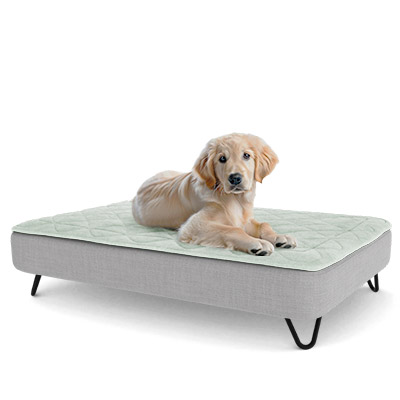As pet owners, we cherish the moments when our furry companions snuggle up for a peaceful slumber. Yet, what happens when our beloved canine companions toss and turn, unable to find the rest they need? Understanding what is affecting your dog’s sleep is crucial for ensuring their well-being and happiness. Let’s delve into the intricacies of what might be keeping our pups up at night and explore effective solutions to promote their quality rest.
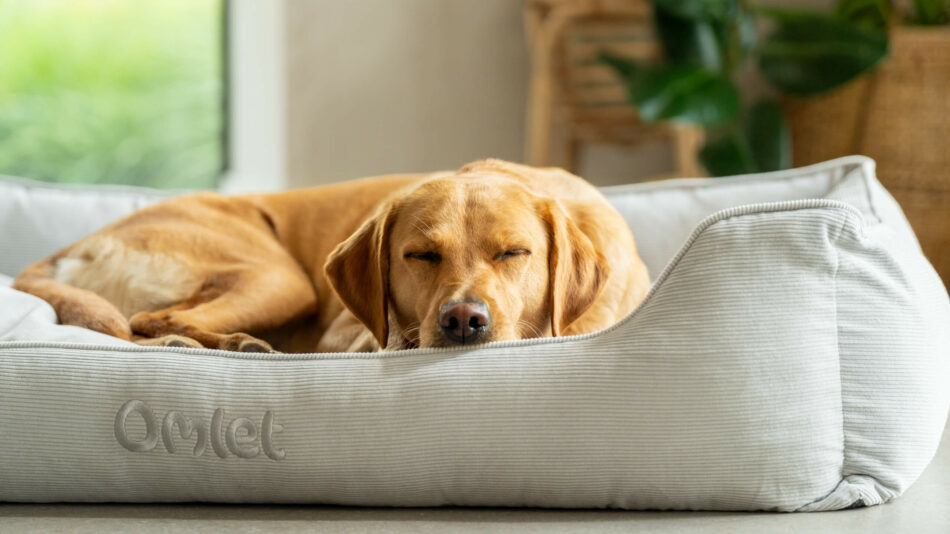
What could be affecting my dog’s sleep?
Ever wondered why your furry friend seems restless at bedtime? It could be anything from an unbalanced diet to a change in routine that throws off their sleep cycle and leaves them in need of some serious R&R. Here’s a look at some of the common factors that could be affecting your dog’s sleep.
Lack of exercise
Just like humans, dogs require regular physical activity to tire their bodies and minds. A lack of exercise can lead to pent-up energy, causing restlessness and difficulty in settling down for sleep. Daily walks, interactive play sessions, or engaging in stimulating activities tailored to your dog’s breed and age can significantly contribute to a more restful night’s sleep.
So grab your dog’s favourite lead and collar and make walking around the neighborhood a daily activity. Or make a game out of hide-and-go-seek their favorite dog toy. As soon as you notice your dog feeling unsettled in their nighttime routine, the fix could be as easy as incorporating more fido fitness.
Underlying health issues
If adding more exercise to your dog’s routine isn’t working, or their age has limited their activity, it may be time to look a little deeper into what might be impacting their sleepless nights. Undiagnosed health problems could be silently disrupting your dog’s sleep patterns.
Conditions such as arthritis, dental pain, or even anxiety disorders can interfere with a dog’s ability to find comfort and relaxation. So it’s important to stay on top of regular veterinary check-ups and pay prompt attention to any concerning symptoms. A healthy dog is a happy dog and happy dogs are more likely to get quality sleep.
Poor diet
Did you know nutrition plays a pivotal role in your dog’s overall well-being? That includes their sleep quality, too. Feeding your furry friend a balanced diet that is appropriate for their age, size, and activity level is crucial not only for their health, but their sleep quality. So if you notice your dog awake more during nighttime hours, it could be linked to diet.
Is someone in the house feeding from under the table when they aren’t supposed to? Is your dog eating too much or too little? Poor diet choices or food allergies can lead to gastrointestinal discomfort which could be keeping your dog awake. Be sure to consult with your veterinarian if you notice sleep issues that you think could be related to food, so you can be sure of feeding the most suitable diet for your dog.
Environmental factors
The environment in which your dog sleeps can significantly influence their ability to rest peacefully. Factors such as excessive noise, uncomfortable bedding, or extreme temperatures are all factors that can disrupt their sleep cycle. Creating a quiet, comfortable, and safe sleeping space for your dog that is away from disturbances promotes better sleep by creating a space dedicated to their relaxation.
Find a dog bed that suits your dog’s sleep preferences. The Topology dog bed designed by Omlet is an excellent choice as it allows you to choose from a variety of Toppers to find textures your dog likes best. You’ll find it hard to pick a favorite, as they’re all designed to zip on and off easily and go straight in the washing machine. Adding some dog feet to the bottom raises the bed off the ground, promoting better hygiene and air flow. To help nervous dogs feel more secure, you can also add a dog crate nook so your pup has a secure space to retreat to when they need a solid snooze.
The Omlet Bolster bed is another great option for promoting restful sleep. A memory foam mattress combined with a full body snuggling cushion, angled to comfortably support their head as they snooze, this is a bed built to compete with the couch.
Change in routine
Dogs love and depend on routine. Disruptions to their daily schedule can cause stress and anxiety which, in turn, can lead to sleep disturbances. So if you’ve noticed your dog’s sleep patterns changing or disruptions in their normal cycles, check if any of these factors are new:
Any one of these factors can cause your dog stress, which could ultimately impact their sleep. So if you do have any upcoming or new changes in your house, do your best to maintain consistency in their daily routine and gradually introduce the changes where possible, so you can help minimize stress and promote better sleep habits for your furry companion.
Ways to prevent or help
When it comes to addressing your dog’s sleep issues it’s best to take a multifaceted approach that is tailored to their specific needs. Use the list above as a guideline to ensure all needs are being met: is your dog getting regular exercise, are they maintaining a balanced diet, and do they have a peaceful sleeping environment? Once you have taken a proactive look at all these factors, there are some additional things you can do to help ensure your dog’s healthy sleep habits.
Try incorporating calming routines before bedtime, such as a gentle massage or soothing music. This can help relax your furry friend and prepare them for a restful night’s sleep – plus the bonding time together is an added bonus. And whenever in doubt, seek guidance from a veterinarian or animal behaviourist as they can provide valuable insights and personalized strategies to address your dog’s specific sleep-related concerns effectively.
Omlet and your dog
At Omlet, we understand the importance of catering to the diverse sleep patterns and needs of all dogs. That’s why we design beds to suit the ergonomics of dogs’ bodies and with durable, upholstery grade fabrics tested to withstand their needs to stretch, turn and roll. All our products are engineered with your pet’s comfort and well-being in mind, offering a range of innovative solutions that will give them the rest they deserve. From cosy dog beds to comforting zen doggie dens, we strive to enhance the sleep experience for all dogs, helping them wake up refreshed and ready for another day of adventures by your side.
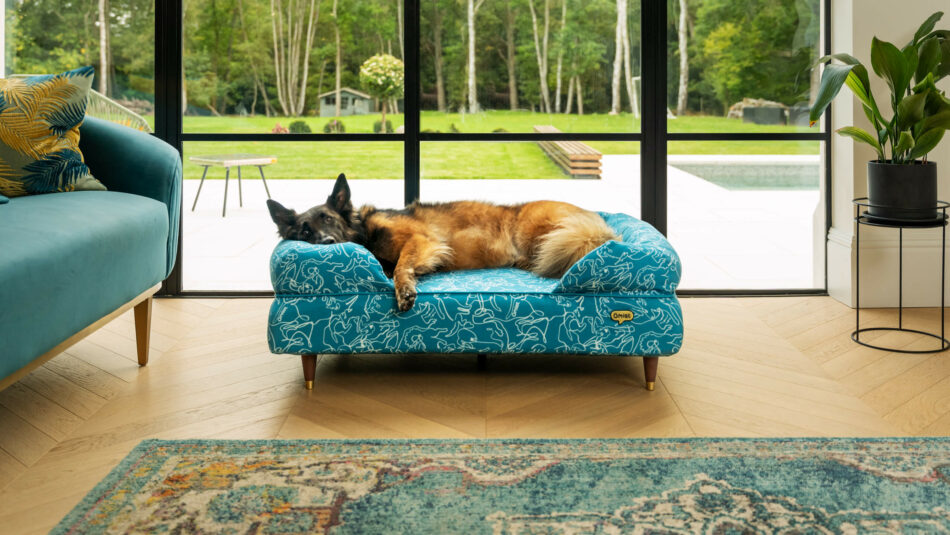

This entry was posted in Dogs
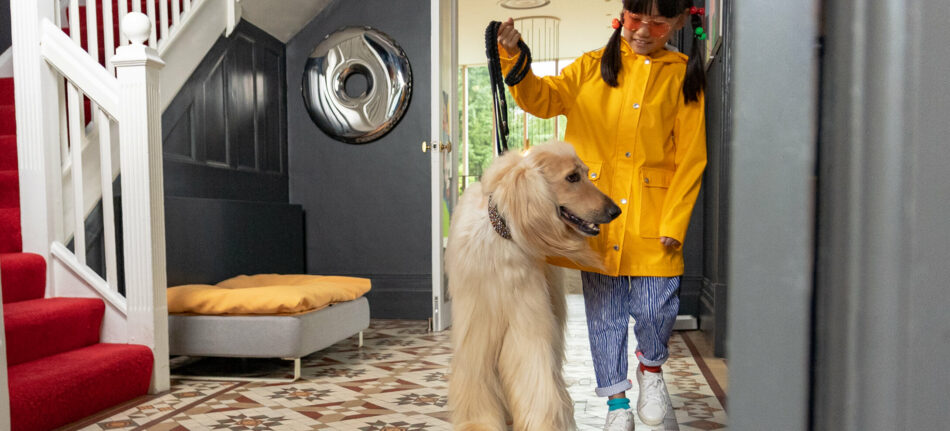
If there’s one thing we can all agree on, it’s that our furry friends bring boundless energy and infectious enthusiasm into our lives. And as responsible pet owners, we want to ensure our dogs live their best lives, filled with vitality and joy. But how do we determine the right amount of exercise for our canine companions? In this comprehensive blog, we’ll discuss everything from the importance of regular walks to the connection between exercise and sleep all to better understand how much you should be working out with fido.
Understanding your dog’s exercise needs
Dogs, like humans, require different levels of exercise depending on various factors such as age, breed, size, and health condition. Here’s a breakdown:
Puppyhood:
Just like kids, puppies need their daily dose of play and activity to channel their boundless energy positively, prevent boredom, and foster good behaviour habits. Regular exercise is crucial for puppies as it promotes healthy growth and development, strengthens muscles, and improves cardiovascular health, setting a foundation for a long and happy life.
Aim for around 5 minutes of exercise per month of age, up to twice a day, for puppies. This helps prevent overexertion and joint stress while still promoting healthy growth and development. Puppies need a balance between activity and rest to thrive, so tune in to their cues and adjust exercise accordingly.
Adult:
Whether it’s a brisk walk, a game of fetch, or a romp at the dog park, keeping our canine friends active not only enhances their physical fitness but also strengthens the bond between pet and owner. Regular exercise is crucial for adult dogs to maintain optimal health and well-being, just like it is for us humans.
Adult dogs generally require about 30 minutes to 2 hours of exercise per day, depending on factors like breed, age, and health status. Regular exercise keeps them mentally stimulated, maintains a healthy weight, strengthens muscles, and promotes overall well-being. A well-balanced exercise routine will make your adult dog feel well for longer.
Senior:
Our furry seniors need their daily dose of exercise to keep their tails wagging and their joints moving smoothly. Regular exercise helps senior dogs maintain a healthy weight, boosts their mental sharpness, and keeps their spirits high, ensuring they can continue enjoying their golden years to the fullest.
Senior dogs typically benefit from around 30 minutes to 1 hour of moderate exercise per day, tailored to their individual needs and health status. This amount helps maintain joint flexibility, muscle strength, and mental stimulation, promoting overall well-being and a longer, happier life.
Size and breed:
Tailoring exercise routines to suit a dog’s size and breed is crucial for their overall well-being. For instance, energetic breeds like border collies require vigorous daily activities such as long walks or engaging in agility training to stimulate their minds and bodies effectively. Conversely, smaller breeds like chihuahuas may not need as much physical exertion but still benefit greatly from short, frequent walks to maintain a healthy weight and prevent boredom-induced behaviours like excessive barking or chewing.
But how often should I walk my dog? That’s where understanding your pup’s specific breed and size matters. Larger, high-energy breeds like labrador retrievers may require at least an hour of vigorous activity daily to keep them happy and healthy, while smaller breeds like pugs may thrive with shorter, gentler walks or indoor play sessions to prevent overexertion and joint issues.
Ideas for exercise routines
Mixing up your dog’s exercise routine keeps things exciting and helps target different muscle groups. So tailor the exercise routine to your dog’s preferences and abilities, ensuring a fun and engaging experience for both of you. Here are a few ideas to consider:
Walks or jogging: While walking your dog might seem like the obvious choice for exercise, making it a habitual routine is what matters. So make it fun – get a dog collar and leash that fits your dog’s personality, lace up your shoes and head out together to walk or jog around the block. You can thank your dog for giving you a reason to stay healthy too.
Explore new places: Ready to take your dog walks to the next level? Spice up your exercise routine by exploring new trails, beaches, or even dog-friendly hiking spots. Let your pup sniff and discover the great outdoors while you both soak in some fresh air and scenery. Just be sure to bring a comfy, easy-to-travel dog bed so they have somewhere to rest on the way home.
Swimming sessions: If your pup is a water lover, like an Irish Setter or otterhound, consider swimming sessions as a great way to exercise. Whether it’s a dip in the backyard pool or a visit to a dog-friendly beach, swimming provides a low-impact workout that’s easy on the joints and a whole lot of fun for everyone.
Agility classes: If you like adventure and think your dog does too, sign up for agility classes together. Not only does it provide physical exercise, but it also stimulates your dog’s mind as they navigate through obstacles like tunnels, jumps, and weave poles. Plus, it’s a fantastic way to bond and boost their confidence.
Fetch and beyond: Engage your dog’s natural instincts with interactive games like fetch, hide-and-seek, or tug-of-war. Grab some dog toys and create a play session in the comfort of your own home to get fido moving. These games not only keep them physically active but also mentally stimulated, satisfying their need for both exercise and mental enrichment.
Doggie playdates: Have you ever seen kids on a playground? They’re running around, engaging in fun and moving their bodies. Well, the same thing happens when dogs get together. Arrange playdates with other friendly dogs to let them burn off energy while socializing. Whether it’s at a local dog park or a friend’s backyard, watching them zoom around with their furry pals is guaranteed to bring smiles, and exercise, all around.
Impact of exercise on sleep
Regular exercise isn’t just about keeping your furry friend fit; it also plays a crucial role in ensuring they get a good night’s sleep. Just like us humans, dogs reap numerous benefits from staying active during the day. When your pup gets their daily dose of physical activity, whether it’s a brisk walk, a game of fetch, or an agility session, it helps to tire them out both mentally and physically. This exhaustion isn’t a bad thing—it’s the key to unlocking deep, restorative sleep.
You’ve probably noticed how your dog flops down contentedly after a day of play, snoozing soundly without a care in the world. That’s because exercise helps regulate their internal clock and promotes relaxation, paving the way for a peaceful slumber. Plus, a tired dog is less likely to engage in nighttime shenanigans like excessive barking or restless pacing. So, by making sure your furry companion gets enough exercise, you’re not only enhancing their physical health but also setting them up for sweet dreams and blissful nights of sleep.
Omlet and your dog
At Omlet, we understand the importance of keeping your pets happy and healthy. That’s why we offer a range of innovative pet products designed to enhance your dog’s well-being. From interactive dog toys to cozy, easy-to-clean dog beds, our products are crafted with your pet’s comfort and happiness in mind. We didn’t invent dog products – we invented designs to make dog products better so you and your dog can spend more time together being happy and healthy.
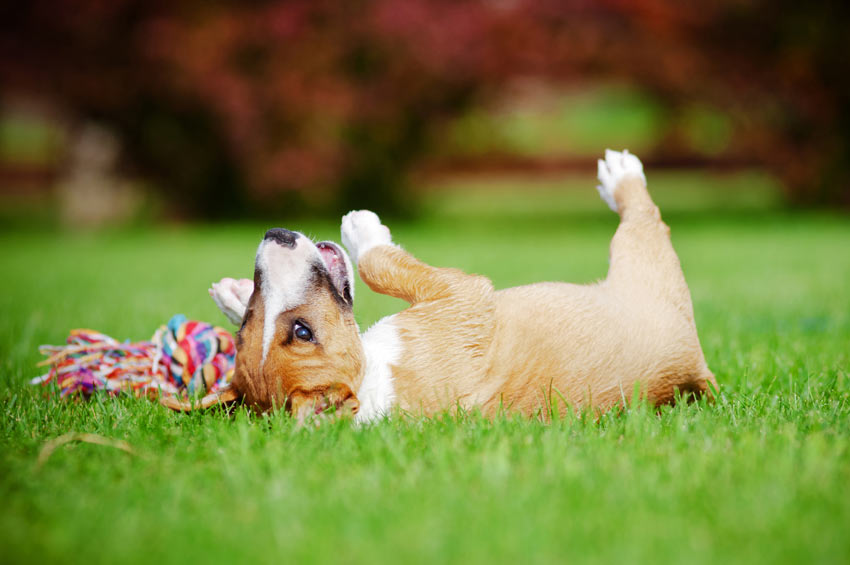
This entry was posted in Dogs

We’ve all heard about sleep schedules for babies and the importance of routine and adequate rest for their growth and development. But what about our furry companions? How much sleep should your dog be getting? As it turns out, just like humans, dogs require a significant amount of sleep to stay healthy and happy throughout their lives. Understanding their sleep needs can ensure we provide them with the rest they require to thrive.
Puppyhood to Senior sleep
Much like humans, the sleep needs of dogs evolve as they age. Puppies, with their boundless energy, may seem like they’re always on the go. However, puppies actually need (and usually get) more sleep than adult dogs. A typical sleep schedule for a young puppy can be anywhere from 18 to 20 hours a day. Because, just like babies, puppies need sleep in order for their bodies to grow.
But as your bundle of fur grows into adulthood, their sleep gradually decreases. Depending on dog breed and size, most adult age dogs will only require about 12 to 14 hours of sleep a day. Senior dogs, on the other hand, will start to log more sleep hours again, often clocking in around 14 to 16 hours per day. Understanding these sleep changes can help you tailor your dog’s specific environment to support their rest.
Why dogs need adequate sleep
Just like humans, dogs require plenty of quality shut-eye to maintain their health and happiness. Imagine your dog bounding through the park, chasing after balls, and eagerly greeting every passerby. Now, picture them doing all that on a measly few hours of sleep. It’s just not feasible. Here’s why our furry companions need their beauty rest:
- Physical recovery: Dogs need sleep to repair and rejuvenate their bodies after a day of activity. It’s during sleep that their muscles recover and grow, ensuring they stay fit and agile.
- Mental well-being: Dogs process a lot of information throughout the day, from learning new commands to deciphering the world around them. Adequate sleep is crucial for consolidating memories and maintaining cognitive function.
- Emotional stability: Have you ever noticed how cranky you feel after a sleepless night? Dogs are no different. Sufficient sleep helps regulate their emotions, keeping them calm and less prone to behavioural issues.
- Immune system support: Sleep is essential for a strong immune system. Dogs need adequate rest to fend off illnesses and stay healthy, just like humans.
So, the next time you catch your canine companion dozing off, rest assured they’re simply taking care of themselves.
The right dog bed makes a difference
Do you think you could get a good night’s sleep on just any mattress? Then your dog won’t either. Providing your dog with the right bed isn’t just about comfort; it’s about their overall relaxation and well-being. A comfortable dog bed is essential in helping your dog unwind, feel safe, and alleviate joint pain, especially for older or larger dogs.
Elevate their sleep: The right dog bed can truly transform your pup’s snooze game. With the Topology dog bed designed by Omlet, it’s not just a surface to crash on. This truly customizable and machine washable dog bed features a raised foot design that improves airflow, ensuring better air quality and comfort for your furry friend.
Surround them in comfort:: Imagine a bed that wraps your dog in complete coziness, like a warm hug. That’s the magic of the Bolster dog bed designed by Omlet. With its memory foam backing, it’s like giving your pup their own miniature couch, offering unparalleled support and relaxation.
Snuggle-worth nesting: Some dogs are all about that nest life. The Nest dog bed designed by Omlet takes plump sleep to a whole new level, providing the perfect cozy spot for pups who love to snuggle up tight. It’s like having a built-in cuddle buddy, minus the slobber.
Versatility meets comfort: When it comes to versatility and comfort, the Cushion dog bed designed by Omlet reigns supreme. Whether your pup wants to lounge in the living room, chill on the patio, or even accompany you on a road trip, this bed’s got them covered—literally. It’s as adaptable as it is comfy, making it a favourite for dogs on the go.
Ideal placement for dog beds
Where you place your dog’s bed can significantly impact their ability to relax and rest. Always opt for quiet, tranquil areas that are away from high-traffic areas and noise. Consider placing their bed in a spot where they can still feel connected to the family without being disturbed.
Additionally, keeping their bed clean is essential. Washable dog beds, like the Topology Dog Bed, make it easy to maintain a hygienic sleeping environment, promoting better sleep and overall health for your furry friend.
Better sleep = better health
Just like humans, better sleep translates to better health for dogs. A well-rested dog is more energetic, responsive, and engaged during walks and training sessions. And when your dog feels well rested and full of energy, you can’t help but reciprocate, further fostering a stronger connection and mutual understanding with each other. By prioritizing their sleep needs, you’re investing in their overall health and happiness.
Omlet and your dog
As pet owners, it’s our responsibility to ensure our furry companions receive the care and attention they need to thrive. Understanding their sleep requirements and providing them with the right environment, including a comfortable dog bed, plays a crucial role in their well-being. Omlet understands these needs and strives to innovate products like our designer dog beds and plush dog blankets that cater to every pet’s needs, ensuring they lead happy, healthy lives. So, next time you tuck your dog into bed, remember the importance of quality sleep for their vitality and longevity.
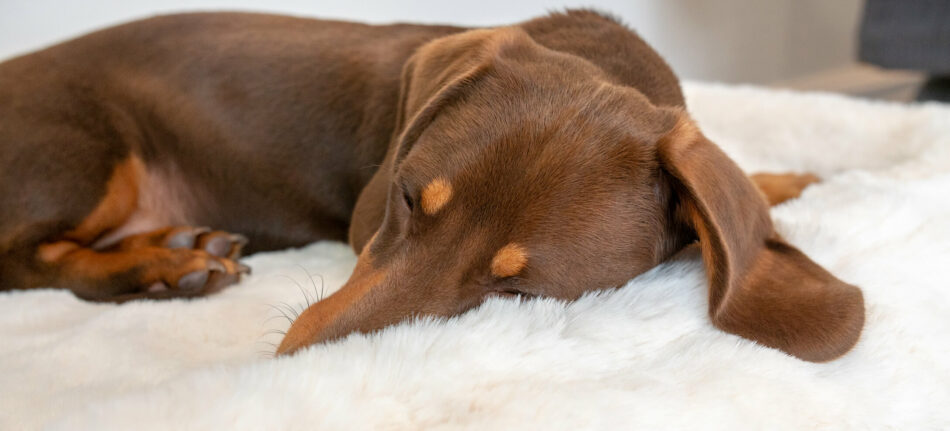

This entry was posted in Dogs
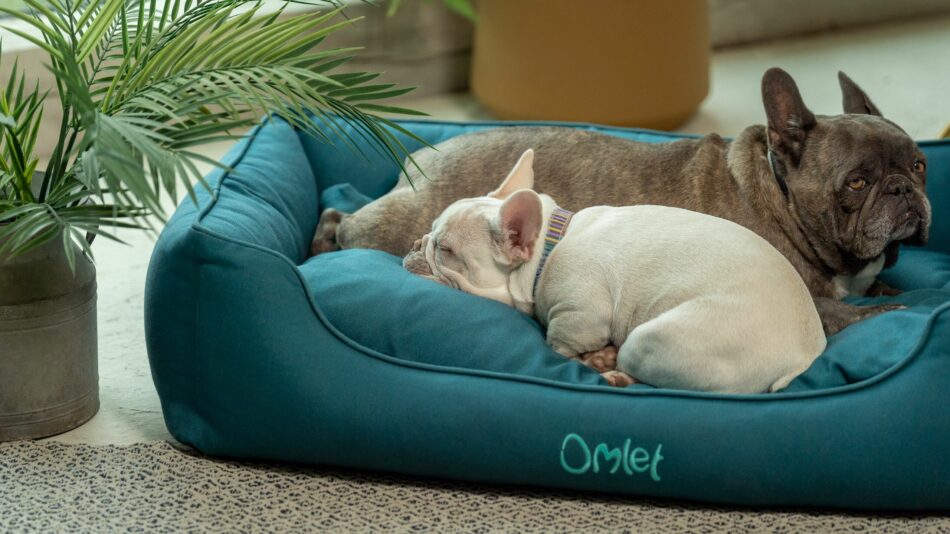
Have you ever watched your furry friend drift off into a deep slumber, legs twitching and softly whimpering, and wondered: do dogs dream? It’s a question that has intrigued pet owners for centuries, sparking curiosity about the inner workings of our canine companions’ minds. Let’s delve into the fascinating world of dog dreams and uncover the truths behind those mysterious nighttime adventures.
The science of dog dreams
Even though our dogs can’t awaken and tell us all about their dreams, scientists have long studied the sleep patterns of dogs to understand if they experience dreams similar to humans. Research indicates that dogs undergo similar sleep cycles to humans, including stages of deep sleep and REM (rapid eye movement) sleep, which is associated with dreaming.
During REM sleep, brain activity increases, resembling that of a waking state, suggesting that dogs in fact do experience dreams. But, our canine companions only experience REM sleep in 45 minute cycles on average. And depending on your dog’s breed and size, their dreams can last anywhere from 1 minute to 10 minutes.
While scientific evidence strongly suggests that dogs do dream, the specifics of their dream experiences remain elusive. Just like humans, dogs process their daily experiences and memories during sleep, leading to vivid dreamscapes that may involve familiar places, activities, or interactions. So the next time you see your furry friend twitching their legs in their sleep, they may just be dreaming about the game of catch you played with them earlier.
What do dogs dream about?
While dogs and humans share similarities in their dreaming experiences, there are also notable differences. Dogs’ dreams may be more heavily influenced by sensory stimuli and instinctual behaviours, reflecting their unique perspective on the world. Additionally, the duration and frequency of dreaming episodes vary among individual dogs, adding further complexity to the comparison.
Although we can’t peer into a dog’s subconscious, behavioural observations provide clues about the content of their dreams. Dogs often exhibit movements and vocalizations during sleep that mimic behaviours seen while awake, hinting that they may be reenacting past experiences or engaging in imaginary scenarios.
As cherished members of our families, it’s natural to wonder if our dogs dream about us. While there’s no definitive answer, studies suggest that dogs likely incorporate familiar faces and interactions into their dream narratives. So yes, it’s entirely possible that your dog dreams of bounding through fields with you or receiving belly rubs on lazy afternoons.
Dreamiest dog sleep solutions
When it comes to ensuring our furry friends get the dreamiest sleep possible, Omlet has you covered with our innovative dog bed solutions. We know sleep is important to dogs – like, up to 18 hours a day (or more) important. So we set out to ask the right questions to invent better ways to care for our beloved pets. Providing your dog with the perfect bed is key to their well-being and their dreams.
For the snugglers out there, the Nest dog bed is like a cozy cocoon, offering a warm and secure haven for those who love to curl up tight. Meanwhile, the Topology dog bed is ideal for leg splayers, providing ample space and support for dogs who sprawl out in all directions. And let’s not forget the Cushion dog bed, a versatile option perfect for on-the-go naps or as a comfy spot in any room of the house. With Omlet, you can rest assured that your furry friend will be dreaming in style and comfort, no matter their sleep habits.
Omlet and your dog
As you watch your beloved pup peacefully snooze, it’s fascinating to consider the vivid dreams they might be experiencing. Understanding this aspect of their lives is just one more way to deepen the bond between you and your furry friend. At Omlet, we’re passionate about enhancing the lives of pets and their owners alike. That’s why we create a range of products that cater to every aspect of your dog’s needs and desires, from luxurious dog beds for the coziest dreams to stylish designer dog collars for those daytime adventures. Because when it comes to your canine companion, only the best will do.
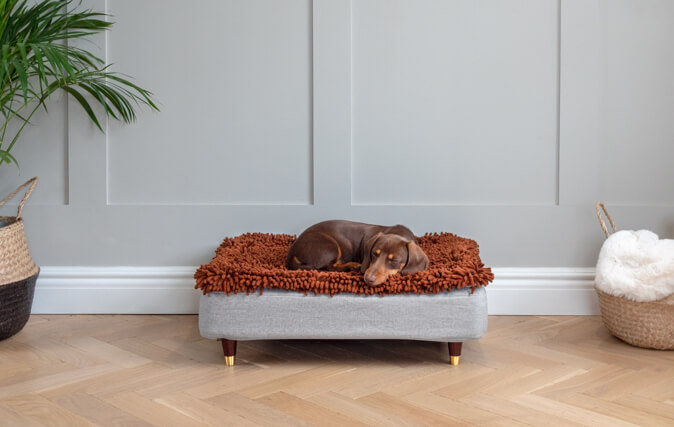

This entry was posted in Dogs
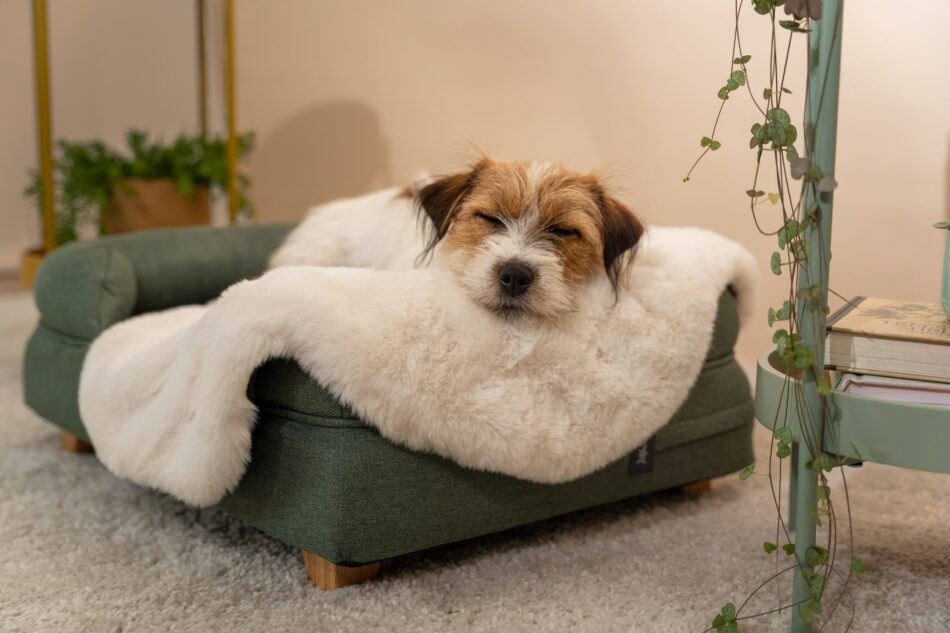
The leaves are falling and temperatures are dropping. Autumn has faded into winter and the crisp air hints at colder weather to come. As you move into winter with a cosy jacket, help your pooch conquer the cold and welcome in the new season by your side. Follow these tips for transitioning your dog into winter and watch them wag their tail goodbye to crunchy leaves and hello to snow-filled strolls.
How cold is too cold?
Most dogs can tolerate cold temperatures pretty well – they do have a built-in fur coat, after all. But how do you know when winter cold is too much for Fido? The best way to temperature check your dog is by looking out for these signs:
- Sitting in a hunched position with their tail tucked in.
- Whining incessantly – this is usually dog speak for “I’m cold – let’s go get warm”.
- Reluctant to go on a walk when they usually love being outside.
These breeds were made for winter
All dogs need some extra care and warmth during the winter months but certain breeds are more susceptible to becoming too cold. Those most likely to need the help of a winter coat are the smaller, short-haired breeds like beagles, pugs, and chihuahuas. Hardier dog breeds such as Siberian huskies and malamutes, on the other hand, fare much better in cooler climates.
Don’t be fooled by their size – there are a few larger dog breeds that struggle in the winter, too. Great Danes, Salukis and German shorthaired pointers are a few examples that are more averse to chilly temperatures due to their shorter coats or minimal body fat.
You’ll want to pay close attention to your dog’s body language on cooler days. Temperatures of 45℉ or below can become risky for long walks or extended outdoor play for dogs susceptible to getting too cold, including older dogs as well.
Winter entertainment essentials
Cold-weather walks around the block may suffice in some parts of the country for dogs this winter, but when the temperatures start to plummet too low, it’s time to move the exercise indoors.
Keeping your dog stimulated indoors is important all year round but especially when conditions mean daily walkies might be off-limits. Here are a few ways to keep your dog active indoors when it’s too cold to play outside:
- Toys, toys, and toys. Whether plush or hard, squeaky or silent, dog toys are an excellent way to keep your dog’s playtime going when indoors. Plus, a game of tug of war or indoor fetch are great bonding activities for you and your pet.
- Hide and see the treats. One of the best ways to get your dog moving is to have them hunt for hidden treats throughout the house. This game doubles as brain training too, so your pup will be able to get both a physical and mental workout in.
- Have a playdate. When it’s too cold to meet up at your favourite dog park, consider having a dog friend over instead to burn off some energy.
- Training and tricks. Take advantage of the extra time with your furry friend by teaching them a new trick. Keep sessions short and be sure to use plenty of treats and praise to get Fido motivated.
Creating your dog’s winter wonderland
To make sure your dog stays snug this season, create a winter wonderland inside by cosying up your quarters. Winterproofing your home for your dog has never been so easy with Omlet’s range of ingeniously designed products to take you through the year.
Nothing’s better than coming home to a warm bed after being outside on a winter’s day. And with Omlet’s Topology Dog Bed not only will you provide your pup with an unparalleled sleep experience on a supportive memory foam mattress, but you can customize their topper from a variety of options that keep them warm and cosy all winter long. Simply zip on a new topper when it’s time to get comfy and zip it off to clean those muddy paw prints with a quick spin in the machine.
Choose from the Sheepskin topper for the ultimate snuggly soft sleep, or for post-snowy walkies, the Microfibre topper is quick drying to get them feeling warm again in no time.
To take their bed to another level of comfort, layer up with the Omlet Luxury Faux Sheepskin Dog Blanket. Or place the plush throw on your bed or couch so you can share a snuggle together. Plus, with three sizes to choose from, you can choose a blanket big enough to wrap around any dog.
Should your dog’s diet change in winter?
While humans may sometimes gain an extra layer of warmth during the holiday seasons, be careful your dog doesn’t follow suit. Just like us, dogs may try and consume more calories during winter to try and create an extra layer of warmth. But, overconsumption of food can lead to health complications in the long run if not watched carefully.
If your dog is active the rest of the year but they start to slow down during winter, you’ll want to maintain a steady calorie intake to not add too much weight. Speak to your veterinarian about switching their diet away from foods high in carbohydrates and more protein and fibre-rich foods to keep them fuller longer.
An extra helping of omega-3 will also be beneficial for your pup this season. This will help with keeping their skin and coat in top condition, free from flaking and itching. Your veterinarian will be able to tell you what they think is best for your pet, but dog-friendly omega-3 supplements are readily available online or in your local pet store.
Omlet and your dog’s winter
Winter can be one of the best seasons, especially with your dog by your side. While you might be spending more time on the couch and less time out on adventures, with products like the Topology Dog Bed, Luxury Faux Sheepskin Dog Blanket and dog toys from Omlet, transitioning into this wonderful time of year has never been easier.
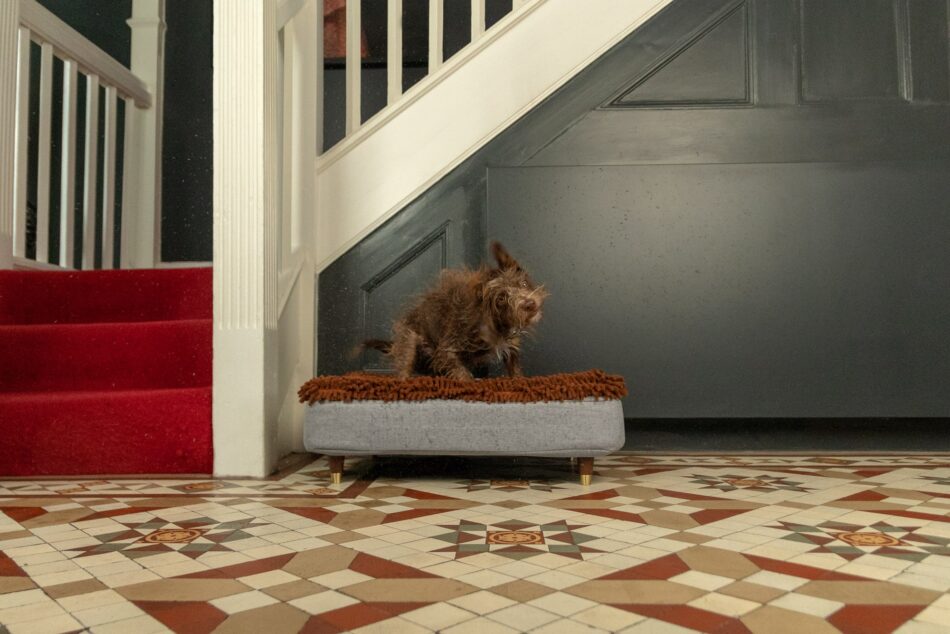

This entry was posted in Dogs

Finding the best dog crate is a crucial decision for pet owners, regardless of whether you have a small, big, high-stress, or elderly dog. It’s an essential tool for their safety, comfort, and overall well-being. With the vast array of options available, the quest for the ideal dog crate can be overwhelming. Thankfully, we’re here to help you navigate this very important decision with various options of Omlet dog crates that are suitable for all pups in all situations.
How to choose the best dog crate for your furry friend
Choosing the best dog crate for your beloved furry friend is like selecting the perfect home – it should be cosy, safe, and tailored to their unique personality. There are three main things to consider when choosing the perfect crate for dog:
First, consider the size; your dog crate should be spacious enough for your dog to stand, turn around, and stretch comfortably, regardless of their size. And remember to also account for your dog’s growth if they’re still just a puppy – as your dog grows, so, too, should their crate.
Next, think about storage. Where are you going to put your dog’s crate? Will it stay in your bedroom? Or will it be front and centre in your living room? Whether you’re using the dog crate just for training purposes, or for a safety spot for them to relax, you will need one that is strong and durable. If you plan on using it as a doggie den for your furry friend, you may want to consider a dog crate that is built more like furniture and can complement your decor.
Lastly, you need to think about how you are using the dog crate. For many pet owners, a dog crate is only used for safety reasons, i.e. travelling in the car to the vet or on holiday. In this case, a dog crate that is easy to collapse and fold is ideal and will make both you and your dog’s lives easier! In addition, an easy-to-transport dog crate also means no hassle, and you’ll be able to move it around your home should you decide to change its location.
Best dog crates for large dogs
Big dogs need big things. And that includes dog crates. So if your furry friend is large like a German shepherd, Labrador, or Bulldog, you’re going to need a dog crate that will fit their size and stature. Our top choice is the Omlet large dog crates as they are designed with larger breed dogs in mind, providing ample space for them to stretch out comfortably and move around in. Its double doors not only allow for easy access, but flexibility of placement as well.
Best dog crates for small dogs
When it comes to small dog crates, Omlet has a range of design options engineered to cater to both the comfort of your smaller dog’s needs and the design of your home. The Fido Studio is a standout choice for petite breeds like the chihuahua, dachshund, or papillion as it offers a cosy den-like enclosure that also doubles as a piece of furniture. With its modern design, your pint-size pup will feel secure and safe in a comfortable spot that blends seamlessly into your home. Store your small dog’s favourite accessories in the optional wardrobe and create a room all their own.
Best dog crates for puppies
When it comes to puppies, dog crates are an essential part of parenting. Not only are dog crates crucial for their safety and puppy training, but for their comfort as well. The Omlet Fido Classic crate is an excellent choice for several reasons. Firstly, it provides a secure space where your puppy can’t get into mischief or danger. Which, in turn, also helps reduce the risk of destructive behaviour!
Second, a dog crate for your puppy aids in-house training by leveraging a dog’s natural instinct to not use their sleeping area as a potty. Consider it a “bladder controller” that helps prevent indoor accidents.
To use a dog crate effectively for your puppy, ensure it’s appropriately sized, allowing them to move around in it freely and comfortably. Introduce positive associations, such as dog treats and dog toys, to make the crate a welcoming space. Then, gradually increase crate time so they become familiar with and used to using it as a spot for security. After a while, you can add a comfy puppy bed inside the crate to make this their designated spot.
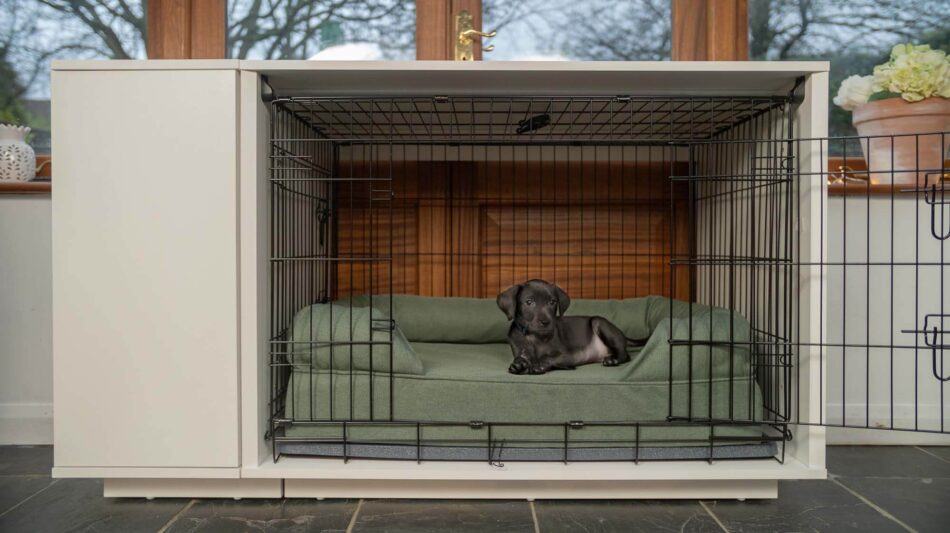
Best dog crate for senior dogs
You may be asking, “why would my senior dog who has lived their whole life without a dog crate suddenly need one?” Great question – we’re glad you asked. As dogs age, their needs change, and a dog crate can become a valuable addition to their life. Some senior dogs start to experience mobility issues or incontinence in their later years, and a dog crate becomes a safe and manageable place where they can rest and recover.
But can you teach an old dog new tricks? At Omlet, we know you can. Training a senior dog to use a dog crate is no different than training a puppy – it takes consistency, patience, and time. When it comes to reducing the stress and anxiety often associated with senior dogs, look no further than the Omlet Fido Nook. Curated with luxury and comfort in mind, this modern dog crate has been meticulously designed to give your dog a sense of comfort and priority in your home.
Best dog crates for travel
Embarking on a pet-friendly holiday should be easy. That was our thought process when we designed the Omlet dog crates to be versatile for travel with your favourite furry friend. Whether you’re road-tripping with your dog in the car or jet-setting across the country, our thoughtful design features help to give you and your dog a hassle-free travel experience. The tool-free assembly of the dog crate makes setup a cinch and your dog will love the cosy interior that keeps them safe during transit. Holidaying with your four-legged family member has never been so convenient.
Best dog crates to calm anxious dogs
Finding the perfect dog crate to soothe your furry friend’s anxiety is like discovering a cosy hideaway for their heart. The Omlet dog crates are not just enclosures, they’re ergonomically designed havens of hushed tranquillity that transform anxiety into calm. Many dogs will whine or bark as a show of their unease but using a dog crate as a calming tool will help give them a safe place where they can feel less overwhelmed.
Best dog crate furniture
At Omlet, we believe dog crates should provide a space of comfort and peace for your dog while simultaneously not distracting from your decor. We asked ourselves, why can’t a dog crate be both functional and modern? And then we made it. Meet the Fido Nook Dog House – where dog crates are elevated to luxury that your dog deserves. Crafted with precision and style, we transformed the mundane dog crate into a statement piece, making your home a sanctuary of style and warmth for both you and your dog.
With the option to add a removable classic crate or just place your dog’s bed directly inside, the Fido Nook is truly the only dog house you’ll ever buy. The integrated closet acts as a storage unit for all of your dog’s accessories and helps to keep your house clean and tidy. This dog house serves as more than just a retreat, it’s a conversation piece in your home that is a testament to your love for your furry friend.
Create the ultimate den for your favourite canine
Now that you’ve settled on the perfect dog crate, it’s time to make it comfortable for them to settle into. Start by adding a cosy dog bed where they can rest and relax. Using a dog bed in your dog’s crate will help train them to know that this is a safe place to be and feel calm. Next, top off their cosiness with comforting dog blankets that keep them warm and snuggled. It won’t take long for your favourite canine to learn that their dog crate is the ultimate den where they can feel secure, comfortable, and at peace.
Omlet and your dog
At Omlet, we go beyond the ordinary to invent the extraordinary, creating remarkable designs that last a lifetime. Whether it’s our dog crates, washable dog beds, raised dog beds, or designer dog leads, we have the products your dog needs and deserves. Our mission is simple: make pet products better so you can spend less time worrying about them and more time with the furry friend you love.
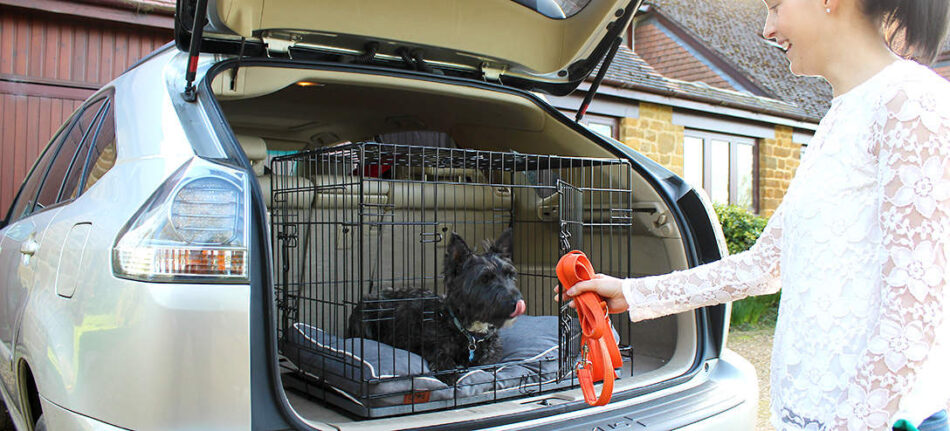

This entry was posted in Dogs
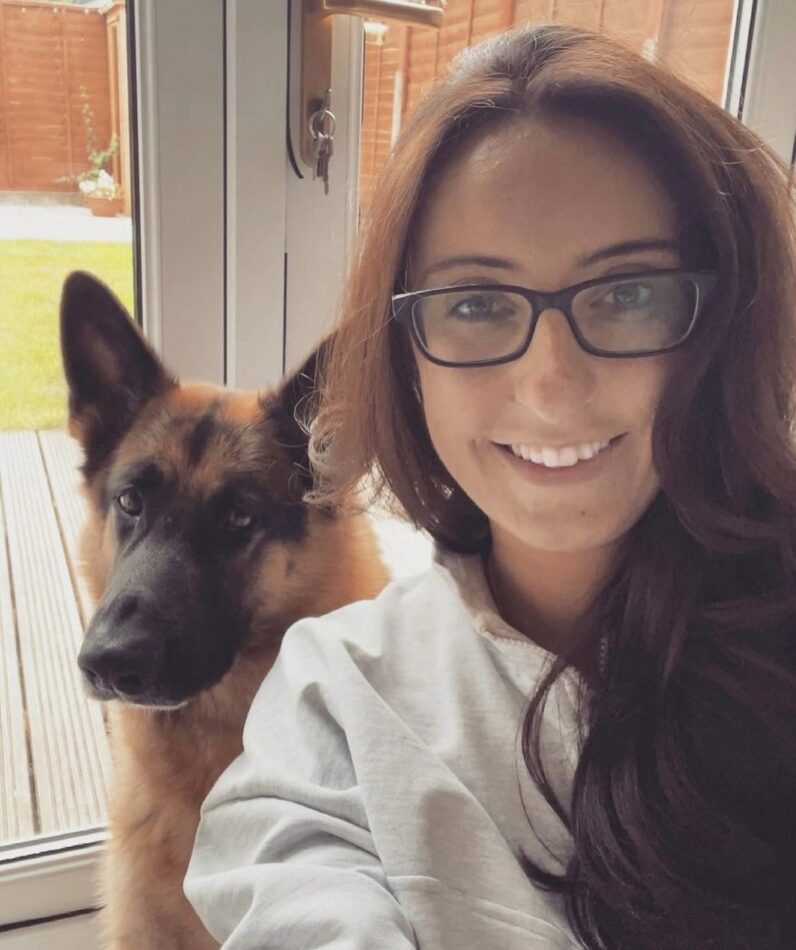
Canine behaviourist, Nikki Mather, explains our dogs’ adolescent phase and provides useful training advice on how to work through this stage successfully. Nikki, founder of Positive Steps Dog Training, is a qualified, force-free dog trainer (IMDT) and behaviourist (BCCS), predominantly working on cases including dog reactivity, separation anxiety and fear/anxiety-related behaviours.
Most new puppy guardians prepare well for bringing home a new puppy, from toilet training to mouthing to sleeping through the night. And, just when you feel like you’ve mastered this stage of your puppy’s life, they turn into a teenager!
The teenage phase is a testing period of your puppy’s life, bringing new challenges and frustrations to you as a dog guardian. During this time, your dog may seem like they are purposely ‘ignoring’ your requests, they may become a little more anxious than before, or they may completely fly off the handle – but let’s take a look at what is really going on for our pups during this stage, as well as training tips to help you navigate this challenging time.
What is adolescence in dogs?
The transition from puppyhood into an adolescent “teenage” dog can happen anytime from around 6 months, lasting until your dog reaches anywhere between 18 – 24 months. During adolescence, dramatic hormonal changes take place within your dog’s body, resulting in a rewiring of their brain.
During your dog’s teenage months, you may notice an increase in their confidence, becoming increasingly motivated to explore and interact within the external environment. Alternatively, your once seemingly confident pup may begin to exhibit more anxious, fearful behaviour. Regardless of the change, it’s important to remember that although older, your pup still lacks the experience and skill set to appropriately navigate our world and, therefore, is sometimes unable to rationally manage their emotions and reactions.
Behavioural changes you may notice
1. Increased anxiety (and therefore reactivity)
Most new puppy guardians are well aware of the importance of appropriately socialising your pup between 8-16 weeks. However, most aren’t aware that our dogs enter into a second fear period generally between 6-14 months.
During this stage, you may notice your once confident pup has become a little more anxious and fearful, which could result in an increase in reactive behaviour towards external triggers they once may have been comfortable around, such as people and other dogs.
In order to work through your dog’s second fear period successfully, it is important to continue their socialisation training to ensure they are continually exposed to triggers at their pace. This will help continue to build positive associations that will create the foundations of a well-adjusted, confident adult dog.
2. Regression in training
We’ve all been there – we bring home a little puppy and immediately begin working on their loose lead skills and recall training. All goes seemingly well…our pups don’t want to leave our side so their lead work is perfect, their recall is second to none and they hang onto every word we say!
Then, the teenage stage hits, and it feels as though everything goes out of the window and our young dogs know nothing!
You’re not alone in this – ‘regression in training’ is completely normal. During the adolescent months, our dogs’ hormone levels change, and they can become much more confident in themselves and their environment. You may notice they listen to you less, they run over to distractions outdoors and they don’t come back when you ask – super frustrating! During this stage, our dogs are often conflicted when asked to do something, driven predominantly by their uncontrolled impulses.
When you begin to notice this regression, don’t panic! You just have to go back to basics in your training – in other words, you need to make it easier for your dog! This might mean you go back to working with a long training lead when teaching recall, or you may give your dog a little more distance from distractions to help them focus on you more. Take the time to work through your dog’s regression, training at a pace they can handle, and you’ll come out the other side with an adult dog that is an absolute dream to have!
3. Ignorance!
During your dog’s adolescent phase, you may become increasingly frustrated by how much they are choosing to ignore anything you ask of them – you may even call this stubbornness! Whilst this may seem like your dog is actively choosing to defy you, it is more effective to try and understand where this ‘ignorance’ has come from.
When they were pups, YOU may have been the most exciting, rewarding thing for them. Now that they’re a little older, their motivators and preferences will change, and you’ll need to up your game in order to keep their attention in a stimulating world.
To do this, you can try using high-value treats to reinforce behaviours you like, such as fresh meats, doggy pate or cheese (within moderation). You can also use chase toys, tug toys or balls to better engage your dog and reward behaviours you like. The more you reward a behaviour, the more likely that behaviour will be repeated!
4. Increased energy levels
As a pup, your dog will have needed around 16-18 hours of sleep per day. Now that they are a teenager, their sleep requirements will reduce, so they may become more active around the home for longer periods of time (more time to get up to mischief!)
Now more than ever, it is important to ensure you are meeting all of your dog’s needs, including physically, mentally, socially and breed-specific. Consider the quality of your dog’s walks, how often do they engage their brain in stimulating activities such as sniffing and problem-solving, do they have ample opportunities to engage in play with you and other dogs (when suitable), and are their breed-specific needs to chase/dig/search etc. being met?
If your dog is restless and exhibiting unwanted behaviours, there is probably an unmet need that needs to be addressed!
5. Nuisance behaviours
The adolescent developmental stage is when most young dogs begin to show troublesome behaviours, such as excessive barking, jumping, lunging, destruction or biting/nipping. Such behaviours are typically a result of your dog working through some pretty big emotions, frustration sometimes making top of the list.
If you notice your dog showing unwanted behaviour, ask yourself WHY? There’s always a function behind our dog’s behaviour – is there something they want, is there a need not being met, are they bored, tired, frustrated etc. Once you understand why the behaviour is occurring, you’re better equipped to implement efficient training solutions!
Quick tips to help satisfy your adolescent dog:
- Let them sniff on their walks as this will tire them out mentally.
- Provide indoor mental stimulation such as enrichment boxes, snuffle mats and treats rolled into a towel!
- Balance high-energy activities with brain work-outs e.g. 5 minutes ball throwing followed by 10 minutes sniffing to help reduce adrenaline.
- Ensure you’re engaging with them through games, training or just cuddles – our dogs are social creatures!
- Teach them how to settle using a settle mat and ensure they have a quiet, undisturbed space to relax around the home.
Remember, your dog’s adolescent period will not last forever. Be patient and guide them into making more appropriate choices to help them co-exist peacefully with you. ‘Bad days’ are inevitable, but your hard work and consistency will pay off, and the relationship you’ll build with your dog along the way will be the most rewarding of all.
If you’re struggling and would like some professional help, please do get in touch with us at Positive Steps Dog Training.
This entry was posted in Dogs
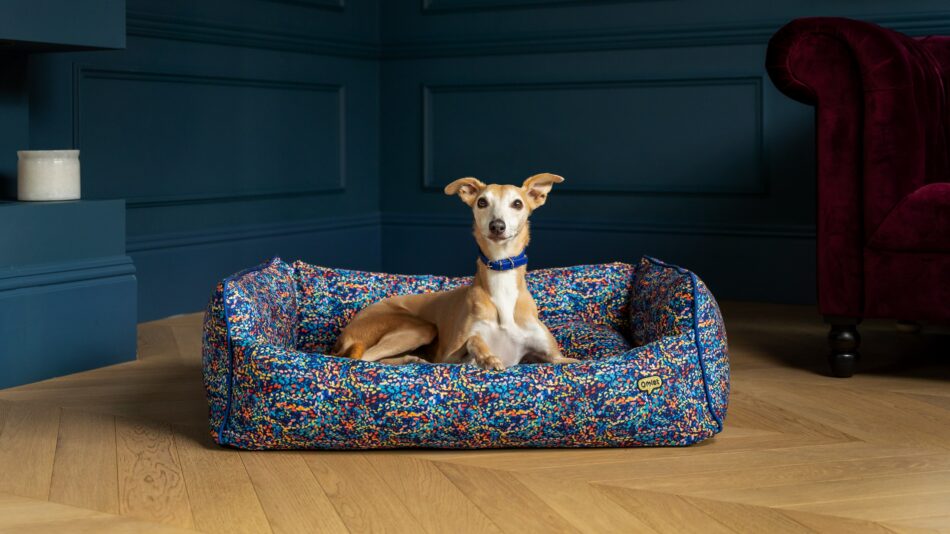 Is there anything more irresistible than those puppy-dog eyes? However mischievous, we love and forgive our dogs unconditionally, even if that means the occasional missing pair of socks. Pet parenthood is far from perfect, but it’s our pups’ mischievous little ways as well as their sweet ones that brighten up our days and make it all worth it. But, when does their behaviour become a bigger problem and what’s the science behind their naughty nature?
Is there anything more irresistible than those puppy-dog eyes? However mischievous, we love and forgive our dogs unconditionally, even if that means the occasional missing pair of socks. Pet parenthood is far from perfect, but it’s our pups’ mischievous little ways as well as their sweet ones that brighten up our days and make it all worth it. But, when does their behaviour become a bigger problem and what’s the science behind their naughty nature?
Loveable rogues
It’s fine, they’re still so little, or perhaps your garden needed a new hole dug anyway…Whatever your excuse for your dog, we’ve all been there. But sometimes there are genuine explanations as to why Fido is acting up. Here are some of the most common naughty dog behaviours and why they happen.
Just one more treat, please
Dogs beg for a number of reasons. Whether it’s to jump up on the couch, for a piece of your food or just for a bit more attention, they definitely know how to make it known when they want something. It’s easy to be fooled by the pitiful whines and pawing of a pooch but this tactic can be a nuisance when it becomes a habit.
If this attention-seeking behaviour has spiralled out of control, it’s important not to reinforce it by giving in to what they want. Instead, try redirecting them to something else to keep them occupied such as a dog toy that they can be alone with, or creating physical barriers such as a baby gate if your dog is begging at the dinner table.
Dogs that dig
The garden should be somewhere for all the family to enjoy but can quickly become the opposite should Fido get their paws dug in. Digging isn’t uncommon, especially for certain dog breeds such as the Airedale terrier, Border terrier and Australian shepherd. While it might be in their DNA, you can deter the digger from your garden and instead, divert them to a more controlled indoor environment with this boredom-busting digging game from our previous blog.
For some, it’s in their genetics, but other dogs dig to relieve stress, to escape or to store their food. Ensure you’re providing them with both physical and mental stimulation and rule out any medical conditions via your vet.
All paws on the floor
Being greeted by a jumping puppy is undeniably cute, but as our pint-sized pups grow into much heavier adult dogs, this behaviour can not only take us by surprise but can also be dangerous. For dogs, a face-to-face greeting with their favourite people is simply a way to get attention as well as to show their affection, so should never be punished.
However, with a bit of persistence, your pup can learn that having all paws on the floor is a much better way to get what they want. Any time they decide to jump up at you or anyone else, turn your back and ignore them. Once they’ve sat nicely, reward them with plenty of dog treats and fuss.
Shoes for chews
From shoes to table legs and even bed frames, a chewing dog is a persistent one and this habit can soon see your entire house gnawed. Before dealing with this issue, let’s first recognize what normal dog chewing behaviour is.
Puppies explore the world through their mouths, which is why they’re notorious chewers. This is perfectly normal, although it’s essential that you provide them with plenty of enrichment, including chew toys so that they don’t nibble what you don’t want them to.
Older dogs, however, may chew due to canine separation anxiety, boredom or an unbalanced diet. Just as with puppies, offer them plenty of toys and dog-appropriate chew bones (not rawhide) while addressing any medical concerns with your vet such as them becoming stressed when left alone.
Fido the thief
Being chased around with something they’ve stolen is a pretty fun game for dogs. And what’s even more fun for Fido, is the chase ending in a game of tug of war with said stolen item. Dogs steal for attention and when we engage with them, it’s simply reiterating that they can take whatever they please and it will result in a play session. Items that smell like us such as socks are firm favourites but disaster can strike when something more valuable is taken.
Teaching your dog the “drop it” and “leave it” commands is a good place to start. With consistency, they’ll soon learn that not taking what you don’t want them to, will earn them an even better reward such as their favourite treat or game.
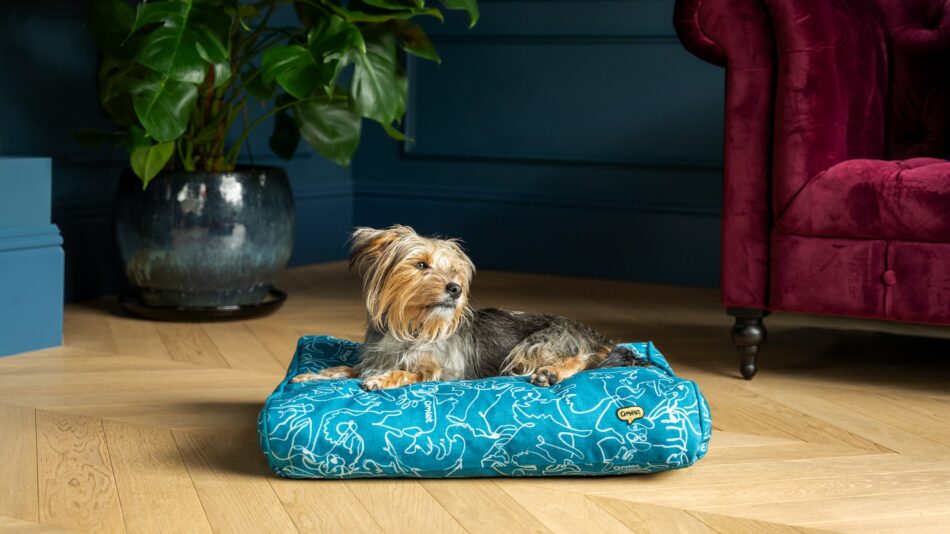
Naughty by nature or nurture?
It’s no secret that some dogs are more naughty than others. Age, for one, is a huge contributing factor, with puppies being the most mischievous of them all. But, it isn’t always a lack of training that leads to naughtiness.
Dog breeds such as the energetic Jack Russell terrier, Siberian husky, Border collie and beagle are also ranked highly on the naughty scale either for their playful nature, apparent inability to resist food or becoming most destructive when not provided with enough stimulation.
The best beds for naughty pups
Muddy carpets. Trash trained from basement to bathroom. But look at that face. Those eyes. We wouldn’t have it any other way. How, we wondered, to tell the story of the mad love and mortification that comes with being a dog parent? With the Mischief Collection we celebrate the ‘shake your head in despair’ delight that only dog lovers understand.
Our in-house textile designer Victoria took it to the drawing board, and so started our latest, limited edition Mischief dog bed collection.
Three on-trend yet timeless prints, inspired by the ‘oh crikey, what now’ moments of sharing your space with a four legged bundle of relentless love, loyalty and face palming frustration.
Evocative of wet pawed, tail wagging wanderers, Patterpaws brings our dogs’ happy-go-lucky optimism to life with an upbeat energy that’s bang on trend.
The frenetic, graphic print in earthy tones of Zoomies traces the invisible tracks they follow as they race and swerve. Seasonal shades of ochre and chartreuse perfectly balance zippy, zany zig zags.
This minimalist, single line sketch design has a Scandi vibe. On closer inspection, Doodle Dog tells a tale of dogs of all types, their movement and motion vividly captured with deceptive simplicity.
Mischievous or more?
A playful pup who has you wrapped around their paw is often nothing to be worried about. But when mischievousness crosses the line, it can become an issue. For example, resource guarding may occur if a dog has stolen an item they deem valuable. Signs include your dog growling, baring their teeth or lunging when approached. Or perhaps what was once a reliable recall has seemingly disappeared. Should you be concerned about your dog’s behaviour, it’s important to seek training from an accredited, force-free professional.
Omlet and your dog
Trouble-making hound or angelic canine, Omlet has the best products to support all dogs and their owners. From easy-to-clean dog beds, to dog toys and dog crates, find out how caring for your pet in a better way is possible through the wondrous world of Omlet.


This entry was posted in Dogs
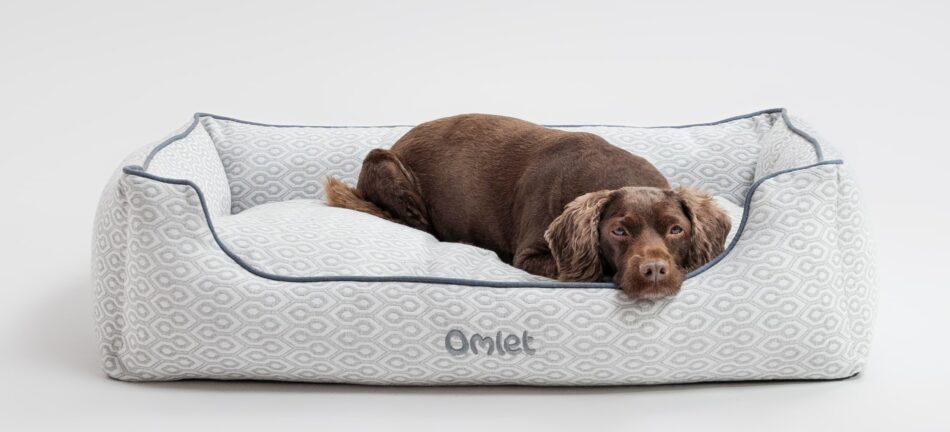
It’s no secret that dogs are smart, but with such intelligence comes an innate need to be stimulated. While your post-work weekday walks might occasionally seem a chore, our canine companions thrive when tested both physically and mentally, so finding activities to help bust dog boredom will prevent them from causing mischief. Here are some ideas to try and keep Fido out of trouble.
Bored dogs – spotting the signs
A bored dog is actually quite simple to spot. If you notice any of the following, then your pup could be trying to tell you they’re in need of more fun.
Destructive behaviour
Chewed-up shoes, gnawed chair legs and loose stuffing dotted around your home… sound familiar? Destructive dog behaviour is frustrating, but behind it all, the cause is often boredom. But with no other outlet for their emotions, dogs often turn to destroying your and their own property.
This being said, some behaviours, such as chewing, are also associated with canine anxiety, as well as puppyhood, which you can read about in our previous How to redirect your puppy’s chewing blog.
Whining and woofing
Notice your dog whining and woofing a lot more than usual? It’s not unusual, especially for certain dog breeds, to make a lot more noise than others, but if you see that it’s becoming more relentless with no apparent reason, this could be another sign of boredom after you’ve ruled out any illness or injury.
Getting dizzy?
Watching Fido chase their tail might initially be entertaining for us to watch, but if your dog is doing so obsessively, this could indicate an underlying problem. In younger dogs, this behaviour is most likely nothing more than a playful pup discovering what that thing attached to them is! But, if you suspect your dog’s tail-chasing is becoming a habit, contact your veterinarian. Should there be nothing of concern, you could simply have a bored canine who needs a little more attention.
Persistent pacing
Restless dog behaviour can include pacing. If your dog is going up and down your home in a frantic manner on a regular basis, then boredom could be to blame.
Off I go!
Got a Houdini hound on your hands? A dog that is frequently attempting to, or successfully, running away from home could be off to find entertainment elsewhere. Losing sight of your dog is a terrifying experience for any owner and when you’re providing such a loving home, it can be puzzling as to why they’d want to leave. Fortunately, most will find their way back and it’s important never to direct your frustration at them. Rather, see this as an opportunity to provide some more stimulation.
Commanding attention
Other than whining and barking, dogs can seek attention in any other way they know that will get their owners to make a fuss (even if it means when they’re getting into trouble!). This can include pawing and nudging, jumping up at you, dropping a toy on your lap and even stealing your favourite pair of shoes. A bored dog is a needy dog, so making sure you provide them with enough stimulation is key to putting this behaviour to bed.
Boredom-busting solutions
Now you know what to look out for, here’s how your furry friend can be on their way to living a more fulfilled and happier life.
Get digging
Dogs love to dig, especially terriers such as the Border terrier, Jack Russell and fox terrier. But, finding them digging up the garden isn’t so fun for us. Instead, encourage their digging instincts by creating a digging box they can use inside the home. All you need is a cardboard box, some scrunched-up paper and a few of their favourite treats to bury inside. Or, you can even use a dog ball pit, hiding treats at the bottom.
Fido fit for purpose
Working dog breeds were originally bred to take on tasks such as guarding, herding and retrieving. Huskies, for example, were bred as sled dogs, while the Bernese Mountain dog was bred as a working farm dog to drive cattle and guard the farm from predators.
Today, many breeds are kept as loving family pets, so it’s inevitably not possible for every dog to fulfil needs they were originally bred to meet. Enrolling them in an activity that resembles their intended “job” can help keep boredom at bay. Finding toys, hide and seek, rounding up toys and throwing their ball in the water to fetch are just a few fun activities you can incorporate into their routine, depending on your dog’s breed.
Back to school
They might have already graduated from puppy training but there are plenty of groups available for adult dogs. This could be further sessions to brush up on their tricks or even agility. If you’re not sure that a class is right for your dog, you can also set up a dog obstacle course of your own at home.
Doggy brain training
With their intelligence akin to that of a child between 2 and 2.5 years old, dogs can really benefit from brain training as part of their boredom-busting routine. Brain training toys, which encourage them to locate their treats such as snuffle mats or Kongs are readily available or can be made at home.
You can try using a muffin tray filled with tennis balls and treats hidden underneath. Or, why not use a few empty yoghurt pots or cups for them to work out which one the snack is under?
Pup playdates
Puppy play dates can be a great way for your dog to exercise. Perhaps you have a friend with a similar-sized dog that gets along with yours, or you can even join local groups of like-minded pet parents. But before you go ahead and unleash your dog, be sure to read our advice on how to make your dog’s play date a success.
Rethink your route
The same scenic stroll might be enjoyable for you but it’s important not to forget that a walk is for everyone involved – Fido included. Exploring a new walking route will give your dog new territory to explore with their nose and also the opportunity to try out training in another environment.
Alternatively, you can even try changing up the pace of your walking or letting your dog lead you. While letting your pup take the lead isn’t a habit you want to fall into, especially for lead pullers, occasionally allowing them to choose where they want to go can be a good way to switch up walks.
Omlet and your dog
And after all that exercise, what better for your pooch to relax than on an ultra cosy Bolster dog bed? A tired dog is a happy dog after all. Continue to discover the wondrous world of Omlet with our range of other dog products such as our dog crates that double as furniture, cosy dog blankets and luxury dog collars and leads.
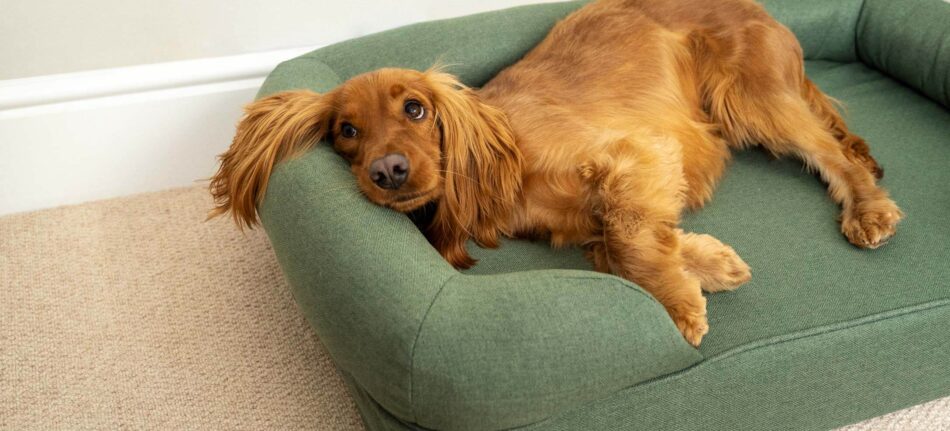

This entry was posted in Dogs
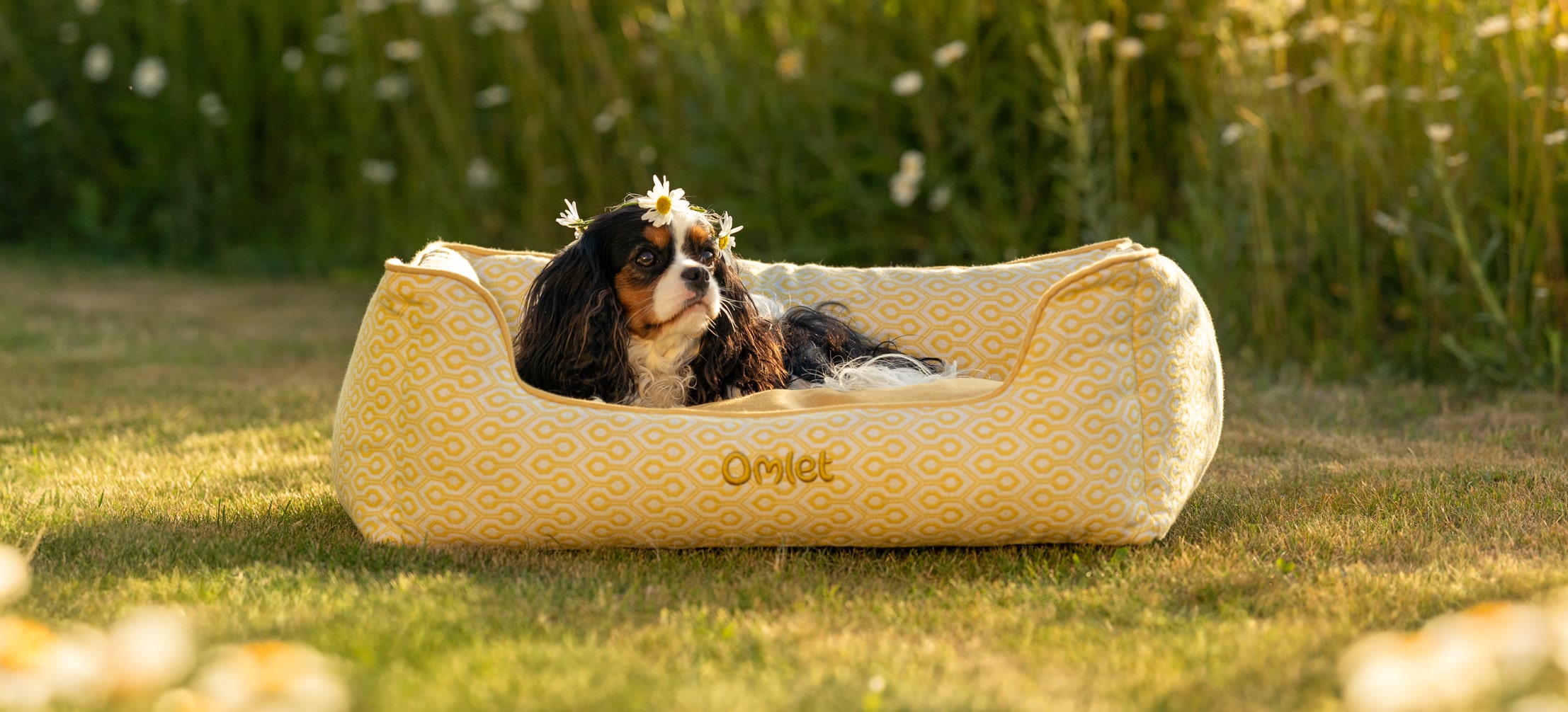
It all started with a dog walk, which inspired our first-ever limited edition signature prints. In this video, hear from our in-house textiles designer, Victoria, the ideator behind our designer dog bed prints and learn more about our steps towards a more sustainable dog bed.
Our latest collection, Gardenia, draws inspiration from our canine companions’ favourite places to wander, sniff and play. Available to
shop now.
This entry was posted in Dogs
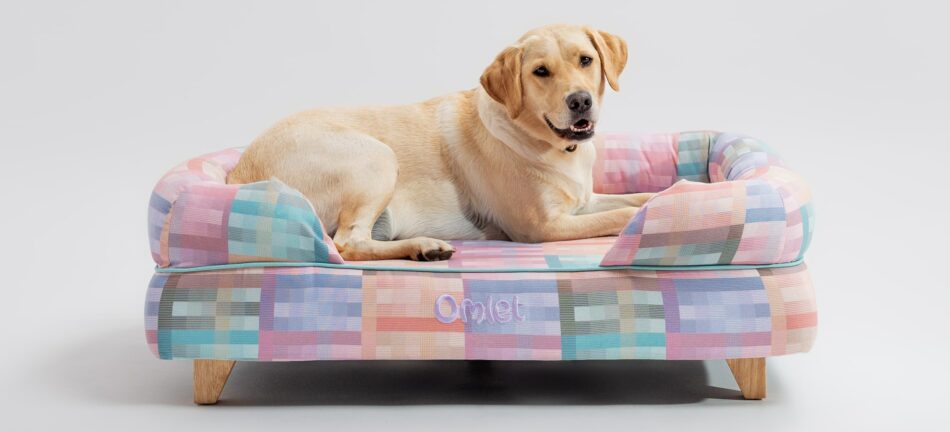
Whether it’s a post-walkies siesta or a full night’s recharge to power up for the next day’s adventure, dogs love to sleep. And with so many hours spent snoozing, where Fido decides to get their shuteye is crucial to getting in those all-important ZZZs. Whilst your dog might enjoy a cuddle on the couch or sneak into your bed as nighttime arrives, having a bed of their very own means a space that supports their specific needs. But with no two dogs quite the same, how do you find the best dog bed for your dog? At Omlet, we’ve made things easy and taken out the guesswork. Here’s our guide to finding your pup’s perfect sleep solution.
From puppy to prime
The standard dog bed only lasts between 6-12 months. We knew we had to do better, which is why we designed a dog mattress to last a lifetime with the Topology dog bed. But, we also understand that a dog’s needs change as they age, which led us to create a range of toppers to support every life stage of your four-legged friend. The Topology toppers can simply be zipped off from the Topology mattress, placed in the washing machine, and then zipped back on for that oh-so-fresh sheets feeling. Or, for when your dog reaches a new life stage, zip on a brand new topper to meet their adjusted needs, all while the memory foam support of the Topology mattress remains the same.
For playful pups
Recently got a puppy? We recommend the Topology dog bed with the Quilted topper, also known as the Topology puppy bed. The durable material of the Quilted topper is great for those inevitable accidents and razor-sharp pirana puppy teeth. Not convinced? We’ll even replace your topper for free with the Omlet 180 Day Puppy Guarantee scheme in the unlikely event that your pup manages to chew through their topper to the extent it can no longer be zipped onto their bed within 6 months of your purchase*.
Super for seniors
For senior canines, opt for the Topology dog bed with the Sheepskin topper. As dogs age, they struggle to regulate their temperature, meaning they need extra support to stay warm. The faux sheepskin fabric not only provides an extra layer of comfort to keep them cosy, but combined with the memory foam mattress of the Topology bed to support ageing joints, creates a recipe for a dog bed of dreams.
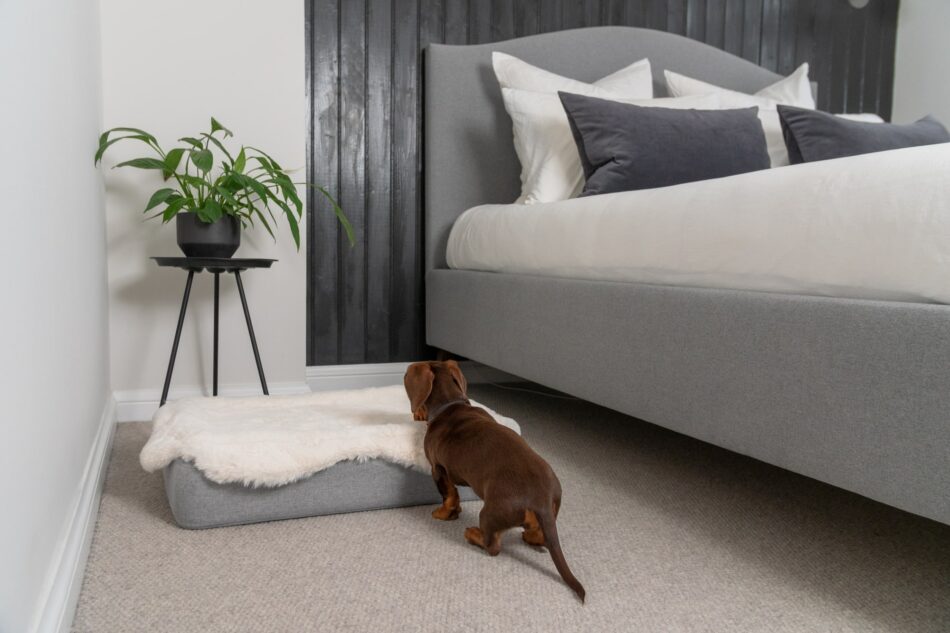
Best for your breed
It’s not just age that affects choosing the right dog bed. When it comes to beds, one size definitely doesn’t fit all and your dog’s breed can also play a part in finding the right sleeping solution for them.
Separation support
All dogs can struggle with canine separation anxiety, but some breeds such as the border collie, toy poodle and bichon frise are more prone to struggling when separated from their owners. Alongside seeking professional help from a behaviourist, having the right dog bed can help, though. The Bolster dog bed was expertly engineered to support the needs of anxious pups, with raised, wrap-around sides creating a pillow for your dog to rest their head and feel cocooned in for when they’re feeling on edge.
Mucky pups
It’s no secret that some dog breeds create a little more mess than others. Whether it’s the flying fur of a golden retriever, a slobbery trail from a bloodhound or muddy paws dotted around the home, our dogs have their own special ways of showing us their love. But, these tokens of love, can come at a cost. With a build-up of dirt, debris and hair, dog bed odours can soon spread to the rest of the home.
Fortunately, the Bolster dog bed has been designed with easy cleaning and home hygiene in mind. The covers can be removed in seconds and put in the washing machine on a gentle cycle. And when the covers are back on, your dog’s bed will feel and smell brand new. Plus, with the option to customize the dog bed with a range of designer feet, the Bolster can be elevated for easy cleaning and 360° airflow.
Suits you
Something else to consider when finding a dog bed is your lifestyle. But finding the perfect fit for you and Fido without compromising on their comfort can be a challenge. We asked ourselves, can we design dog beds that meet their needs and ours? Our answer: Yep, for sure. Whether you’re an avid adventurer who loves globetrotting with your canine companion at your side or a homebody interior expert who wants to match their dog bed to their furnishings, we have a dog bed for you.
Adventure ahoy
The Cushion dog bed is the go-anywhere dog bed. The lightweight material means taking your pup’s bed on your travels is a breeze. Keep it in the car for your next adventure, and bring it out when you’re ready to bed down at your destination. And filled with the just right amount of plump stuffing, the Cushion dog bed ensures your four-legged friend stays comfortable wherever they are.

Here for the homebodies
Perhaps a slow stroll with your dog followed by a cosy evening in your beautifully decorated home sounds more appealing than a camping trip with Fido? We’ve got a dog bed just for you, too. Our Nest dog bed has been designed to give your dog the ultimate night’s sleep with dual-side cushion inserts, whilst looking amazing in any home as well.
Choose from a range of sustainably sourced covers in signature prints, exclusive to Omlet. For those who want a bold pop of colour, the abstract Kaleidoscope Prism or Shaded Spruce prints will work great. And to complement any minimalist interior, the subtle tones of the Corduroy Pebble and Corduroy Moss covers are ideal.
Omlet and your dog’s bed
No two dogs are the same, so we don’t expect them to have the same needs and desires. That’s why we’ve designed a comprehensive collection of dog beds that meet their needs – and yours too. From the Bolster dog bed for extra support, to Topology dog beds for those all-important life stages, to the sustainable and beautifully designed Nest dog bed, or the Cushion dog bed to travel anywhere, we believe the perfect dog bed makes life with your dog that bit more magic for you both.
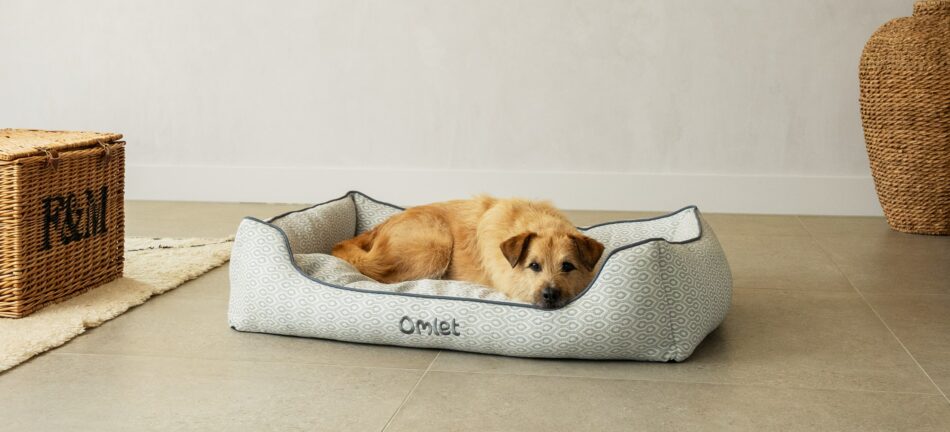

*180_Puppy-Gaurantee_terms | Omlet
This entry was posted in Dogs
Rachel Spencer is a freelance journalist specialising in writing about pets and the pet industry and an award-winning pet blogger.
She welcomed her first rescue dog Daisy, a terrier cross, into her life in 2009, and this inspired her to start The Paw Post pet blog, writing about animals and the difference they make in people’s lives.
Rachel rehomed her second terrier, Patch, in 2018 and together they enjoy travelling to dog-friendly destinations and trying out the latest in doggy toys, treats and technology.
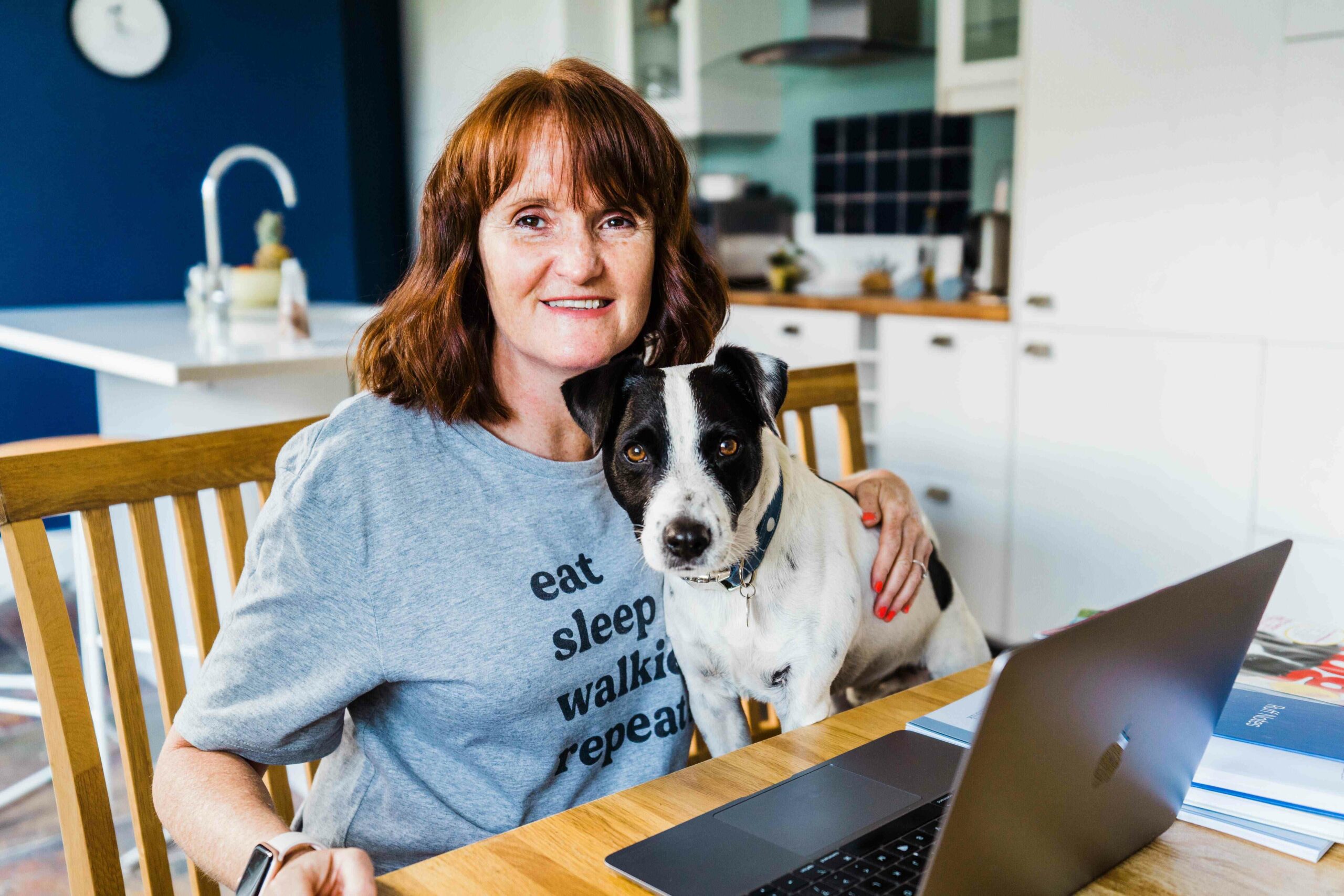
Welcoming a rescue dog into your home and your heart is a wonderful thing to do. You gain a faithful companion to give you unconditional love, and your dog gains a second chance at happiness. As a new pet parent, it’s key that your dog settles in your home and these seven tips will help you establish a routine.
1. Buy the basics
Stocking up on the following items ahead of your furry friend’s arrival will help them feel right at home.
- Food – ask the rescue or former owner what they are used to eating.
- Food and water bowls
- Collar, lead and tag with your contact details on – you’re legally required to include your name and address on and consider your phone number too.
- Toys
- Bed and blanket – the Omlet Topology Luxury dog bed is ideal, with washable and removable toppers and the option to pop a blanket over the top.
- To help your dog settle, snuggle under the blanket before they arrive so it carries your scent.
2. Give them space
Welcoming a new furry family member is exciting, but they will likely be tired and a little overwhelmed. They might be shy at first too, so be patient. Given time, they’ll interact and become more confident and playful.
They’ll need some peace and quiet so set up their bed or a crate, treats and a toy in a quiet room or area so they can retreat if they need some time alone.
3. Start exploring
For the first few days, take short walks in your local area and allow your dog to sniff and explore their new surroundings.
Avoid busy places with lots of dogs and leave their lead on to ensure they’re safe, then build up to longer walks in new places.
4. Monitor their progress
Consider keeping a doggy diary, so you can record how they settle in, their likes and dislikes, training progress and behaviour when left alone.
Rescue dogs may experience separation anxiety, so consider using a pet-cam to watch how they react when you leave them.
5. Connect with local pet professionals
Book an appointment with your local vet for regular checks, worming and vaccinations. This will help your pet get accustomed to the vet.
If they require regular grooming, you could also visit your local salon with your pup to discuss their grooming routine. During these visits, feed your dog treats to make it a positive experience.
6. Begin training
Dogs love to learn. Find a local, accredited, force-free trainer to teach you kind and ethical ways to communicate and bond. Choose from classes or one-to-one for professional guidance, and a chance for your dog to meet other dogs.
7. Look forward to years of happiness
There is a wonderful quote from psychologist Emma Kenney, “Opening up your life to a dog who needs a home is one of the most fulfilling things you can do.”
Whatever their past, your rescue dog can look forward to a new life by your side, from walks in the woods to cuddles on the sofa. By taking these simple steps to help them settle, you’ll be paving the way for shared adventures for years to come and a lifelong bond that’s hard to beat.
This entry was posted in Dogs
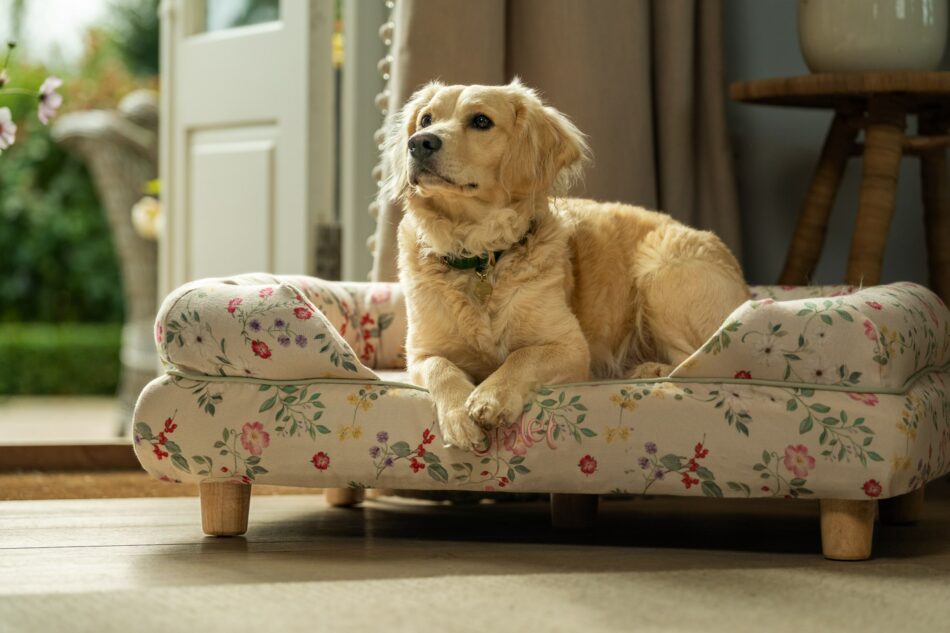
Our rescue dog checklist can help guide you to what to consider before adopting and the essentials you’ll need for your new pup. These four-legged furballs are superheroes in disguise who inevitably bring endless joy, love, and laughter into your hearts and home to create an incredible tail-wagging adventure. But before you embark on this journey, it’s essential that you are prepared for their arrival. In order to be the best rescue dog superhero parent, you need to have the best products. Let’s take a look at this epic rescue dog checklist that will ensure you’re ready to welcome your canine hero home with happiness.
Why rescue a dog?
It goes without saying that one of the best reasons to rescue a dog is to save a life. But did you know that by adopting a rescue dog, you’re not only saving the life of that dog, but another as well? When you bring a rescue dog home, you’re making space at the shelter for another rescue dog to take its place, in turn saving yet another life.
4 important reasons you should consider a rescue dog:
- Unconditional love: Many people worry about adopting a rescue dog because there are several unknowns associated with it. But the truth is, whether you get a new puppy from a breeder or a rescue dog from the shelter, there will be a lot of uncertainties for everyone. Rescue dogs have grateful hearts and an appreciation for their new life that is shown through unmatched and unconditional love.
- More exercise: No matter what dog breed you rescue from a shelter, all dogs need exercise. And as their new pet parent, you just became their exercise companion. Whether you’re looking to lead a more active lifestyle or not, adopting a rescue dog means you now have the ability to get out and enjoy the great outdoors more often.
- Social outings: Dog people like to hang out with other dog people – it’s a thing. So when you adopt a rescue dog, you’re given the opportunity to interact and socialize with new people. Meetups at dog parks or dog-friendly restaurants are a great way to make new dog friends for your rescue and new human friends for yourself.
- Built-in bestie: What’s better than a lifelong friend that showers you with love and joy every time you’re around? That’s what it’s like with a rescue dog! A constant playmate, confidante, and snuggler, rescue dogs are not only your friend for their life, but they also become a beloved family member. Who could ask for anything more?
What to consider before rescuing a dog?
When it comes to rescuing a dog, knowledge is power. So before you dive headfirst into the furry adventure of pet parenting, there are a few things you should consider.
- First off, assess your lifestyle. Dogs, especially rescue dogs, require time, attention, and care. Are you ready to commit to walks in the rain, cleaning up hair and potential messes, and dealing with the occasional chewed-up shoe? Adding a rescue dog to your family needs to be a family decision so it’s important that all members of your household, two-legged and four-legged alike, are on board and ready to welcome a new member to the brood.
- Next, consider your living arrangements. Dogs come in all shapes and sizes, but small apartments may not be best suited for large dogs and large homes may have too much space for small pups to feel secure. Understanding different dog breed personalities and energy levels will also help you better decide which rescue dog would be the best fit for your family.
- Lastly, the financial obligations that come with rescuing a dog should be on your radar. Just like humans, dogs need the basics such as food, dog toys, and regular vet visits. But it’s important to factor in all costs associated with dog parenting so you are prepared for any unexpected costs that may arise. Just remember, owning a dog may be an investment in your bank account, but the investment you receive in love is far greater.
Choosing the right bed for your rescue
Finding the right dog bed for your new canine companion is an important step as it will quickly become both a sleep spot as well as a familiar friend. Keep in mind that many rescue dogs may be nervous or scared during their first few weeks in their new home, so having a comfortable dog bed that gives them a sense of security can make all the difference.
Importance of supportive beds
The Bolster dog bed, by Omlet, is uniquely designed to create that sacred space that any rescue dog will love. The supportive cushioned surround emulates a safe, cosy spot where your rescue dog can retreat to if they’re feeling overwhelmed or shy. Or, they may just curl up there often because it’s so comfortable
And speaking of comfort, the Bolster Dog Bed is designed with a premium memory foam mattress that is luxuriously supportive. While rescue dogs come in all ages, many are in, or closer to, their senior years and may have more sensitive joints. The Bolster Dog Bed gives them that comfort assurance they need to rest on well into their golden years.
Easy-to-clean dog beds
But what you’ll love most about the Bolster Dog Bed are the customizable colour options and ease of cleaning. Choose from a variety of covers in different colours or limited edition prints that best match your decor. When they get too dirty or smelly, simply zip it off and toss it in the washer for a like-new clean. Finally, a dog bed that every member of the family will love!
What else you’ll need for your rescue dogs
Once you have the perfect dog bed, you can add on to your rescue dog’s comfort with additional items to make them feel more at ease and settled in.
4 products to make your rescue dog’s homecoming the best one they’ll ever have
- Blanket: Your rescue dog will still be getting to know you during their first few weeks at home. And one of the best ways to create a strong bond with them is by allowing them to know your scent. Adding a soft dog blanket to your rescue dog’s bed not only gives them an added layer of comfort, but another way to get closer to you. Simply wrap the blanket around yourself before placing it on the bed so your scent stays with them always.
- Crate: If your rescue is showing signs of uneasiness, you can help them feel safer and settled by adding a dog crate to their routine. The Fido Nook, designed by Omlet, is a great option because it feels less like a standard wire crate, and more like a personalized home within a home. You can even place their dog bed directly into the nook to create the ultimate rescue retreat.
- Dog bowls: With meals served 2-3 times a day, the dog bowls your rescue eats out of are important. Make sure you buy one that is easy to clean and sturdy – neither you, nor your rescue wants spilled food at dinnertime.
- Dog toys: One of the best parts of being a rescue dog parent is getting to spend time playing together. And while walks outside or in the park are super important, nothing beats the one-on-one engagement that comes from playing with your dog. So be sure you have plenty of dog toys on hand so you and your superhero hound can spend lots of time getting to know each other better.
Omlet and your rescue dog
At Omlet, we value the bond between pet parent and pup above all else. We create our products based on our own personal pet parenting experience and understanding of not just what your pets need, but what they want. And rescue dogs are no different. Our Bolster dog bed will welcome your new canine companion home with comfort and ease and allow you to focus on what matters most – connecting with your new best friend.
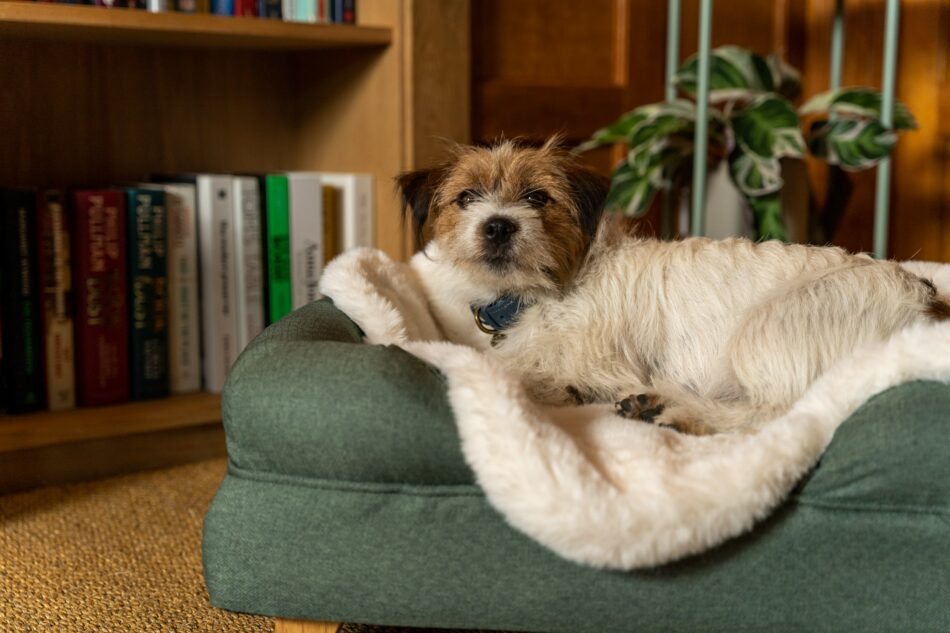

This entry was posted in Dogs
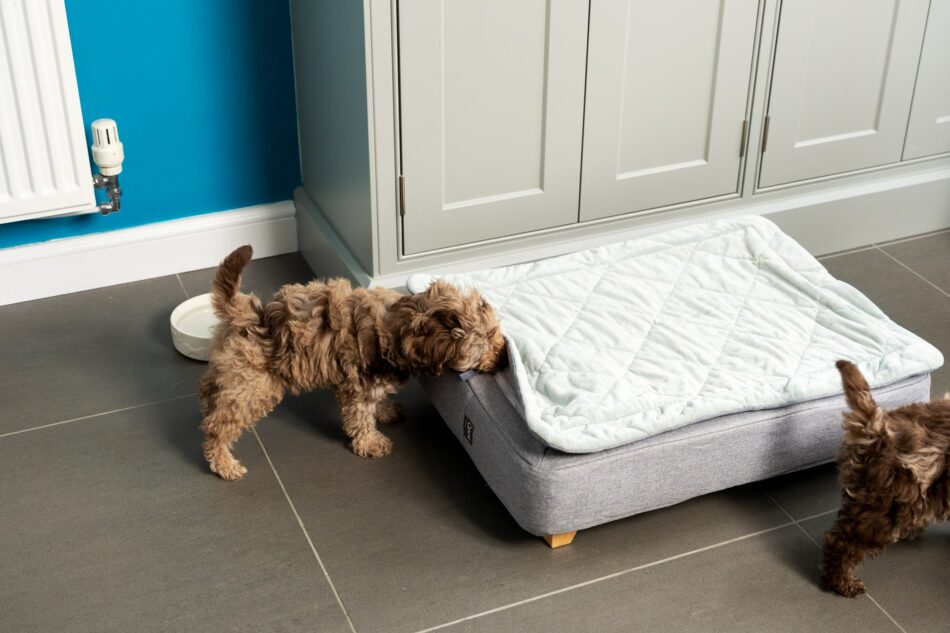
Ahh, the eternal question: how long should a dog bed last? It’s a topic that’s stumped pet owners for ages. As humans, we typically change out our mattresses every 6-8 years depending on brand and usage. But with dog beds, there are a lot more factors to consider. Should a dog bed last a year? Five years? Ten years? Or should it last until the end of time itself? At Omlet, we think dog beds should last forever! So let’s take a closer look at your dog’s bed and what you can do to keep their comfort going for life and keep their bed out of the landfill.
Why standard dog beds don’t last
Let’s be honest – dogs are known for many things, but being gentle with their belongings is usually not one of them. They love to chew, dig, and drool on anything they can get their paws on, including their dog beds. In addition, most dogs sleep on their beds for all naps and nighttime sleep, incurring lots of usage and extra smells. It’s fair to say that dogs use their beds more than humans use their mattresses.
As a result, standard dog beds simply can’t withstand the normal wear and tear of any dog breed. Most standard dog beds are constructed of non-durable and non-washable materials, making them unable to provide quality comfort for your dog for very long. So if you’re expecting a standard dog bed to last forever, you’re barking up the wrong tree. But rest assured – there are other dog bed options from Omlet available that will keep your canine comfortable for life.
How long should a dog bed last?
On average, most standard dog beds last anywhere from 6-12 months. If it’s not the rips and tears from your dog’s natural behaviours that prematurely send it to the landfill, then the build-up of odours and hair will. At Omlet, we believe that dog owners should be able to buy one dog bed that will last their furry friend from puppyhood to prime.
Our product designers set out to challenge the standard dog bed norm and create a dog bed that would not only provide the highest quality comfort to your dog, but would last their lifetime as well. Their solution – the Topology dog bed.
3 ways to know it’s time for a new dog bed
How do you know when it’s time to buy yourself a new mattress? More than likely, it’s when you start having consecutive nights of uncomfortable sleep or can see defined lumps and dips throughout. But how do you know when it’s time for your dog to have a new bed? Here are 3 ways you can determine if your dog needs new digs:
The two most common dog bed fillers are stuffing and memory foam. So in order for any standard dog bed to stay supportive of your dog’s joints and comfort, the interior filling needs to be uniformly thick across. But how can you tell? By performing a quick thud test. Simply take your flat hand and hover it a few feet above your dog’s bed. With a swift motion, drop your hand onto the dog bed to mimic your dog plopping onto their bed. If you hear a ‘thud’ when it hits, then it means the supportive filling has gone flat and it’s time for a new dog bed.
No really, we mean it – smell your dog’s bed. And we don’t mean from the other room. We mean get down on the ground and give your dog’s bed a good whiff. Any bacteria or other microbes that may have started to build up inside your dog’s bed may only be fragrant up close. But guess what? That means this smell is transferring to your dog every time they snuggle up for a snooze. So if you sniff a bad whiff it’s time for a new dog bed.
-
Give a complete inspection
At first glance, most standard dog beds may appear to be in perfectly good shape. But give it a closer look and you may see something else. In order to really know if your dog needs a new bed, you need to give it a thorough inspection. If the cover is removable, take it off to look at the insert. Mould and mildew can hide in seams and crevices from excess drool, making your dog’s bed worse for wear. And if the inside of your dog’s bed looks that bad, imagine how uncomfortable it must be.
Omlet’s Topology dog bed
As the pet company that does things differently, we set out on a quest to create a comfort solution that would be your dog’s sleeping companion for life. We’re pet owners, too, and like you, we’re tired of worn-out, uncomfortable dog beds filling up our landfills. So we decided to do something about it. We decided to engineer the last dog bed you’ll ever need to buy.
The Topology dog bed, designed by Omlet, is a completely customizable dog bed that will literally transform your dog’s sleep. The luxurious memory foam mattress is completely encased in a water-resistant cover to give your dog high-performance sleep without the worry of bacteria build-up. And with Topology, you can also customize your dog’s comfort with one of the multiple different topper options so you can give your dog the exact sleep they want.
The best part? Every single topper is easy to remove and completely machine washable. Simply pop a new topper on the bed while the other is in the wash, or if a topper gets worn out, simply replace it with a new one without having to buy a new bed.
In fact, we know this bed is so durable and high-quality that we guarantee it can withstand the harshest of critics – puppies. Yep, that’s right. With the Omlet 180 Day Puppy Guarantee, we back the Topology dog bed and Quilted topper, AKA the Omlet Topology Puppy Bed to withstand the shark-like chewing of every dog bed’s worst nightmare. If within 180 days your puppy chews through the Quilted topper of the Topology bed, we’ll replace it for free. How’s that for the last dog bed you’ll ever buy?
Omlet and your dog
At Omlet, we don’t just assume we know what your dog needs in a dog bed. We use our personal experience and unparalleled understanding of the best products available to engineer dog beds that deliver quality, comfort and ease of care so your dog not only gets what they need, but also what they want. After all, our dogs deserve the best, right? With the Topology dog bed, your dog will be laying in the lap of luxury from puppyhood to prime and giving you many tail wags of thanks in return. Let us do the work, so you can reap the rewards.
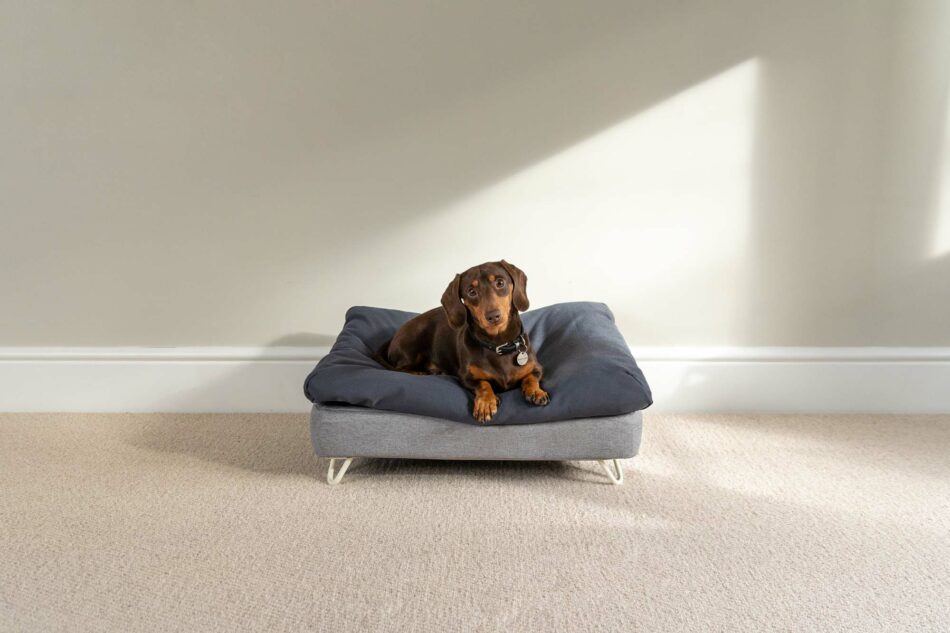
This entry was posted in Dogs
Golden retriever puppies are undeniably adorable with their fluffy coats and playful personalities. But there’s one thing that can drive their pet parents crazy: their propensity to chew on everything in sight. From shoes to furniture, these pups seem to have an insatiable desire to gnaw on anything they can sink their teeth into. But why do golden retriever puppies chew so much? And, is there anything you can do to stop them?
Let’s get to know the goldens
Sweet, loyal, lively and incredibly good with kids – it’s no wonder golden retrievers are one of the most popular dog breeds in the UK. But what makes this breed so, well, golden? Let’s go back to the 19th century when they were first bred to find out.
In 1868, Lord Tweedmouth of the Scottish estate of Guisachan was interested in sporting and hunting dogs and finding one that could handle the Scottish climate and terrain. After failing to find any existing breeds that could keep up, he decided to create his own. By breeding a flat-coated retriever with a tweed water spaniel, Lord Tweedmouth helped create what we now know as the beloved golden retriever.
As seen in their medium to large size stature and solid, athletic build, the golden retriever has the sporting and retrieving genes all through their DNA. Coupled with their high canine intellect and effortless ability to learn commands, it’s easy to see why the golden retriever has long since been known as the preferred dog for hunting.
But even though the sport has been domesticated out of the golden, the instinct to catch and carry is still strong in this breed. Hence the reason these dogs, especially as puppies, like to put everything in their mouths.
Do all puppies chew?
Puppies use their mouths to explore the world around them, so it’s fair to say that there’s a method behind the madness (and destruction) of this natural behaviour. Here are some of the reasons puppies chew.
- Stress relief: Puppies, in particular, use their mouths to help them cope with stress. And when they come home with you, dog separation anxiety can continue when they see you leave the house or even just the room. Chewing helps to soothe their anxiety and provides a source of comfort.
- Pain relief: Chewing is also an essential part of a puppy’s teething process. As puppies grow, their baby teeth fall out, and their adult teeth grow in. This can be a painful process, and chewing helps alleviate discomfort by massaging the gums and providing an outlet for the growing teeth. It’s not uncommon for puppies to chew more during this time to seek pain relief.
- Exercise relief: All puppies require plenty of exercise and stimulation to keep them happy and healthy. When they don’t get enough run and play time, puppies can become bored and restless, and chewing becomes a way to alleviate that boredom. Providing plenty of dog toys, exercise, and attention can go a long way in curbing unwanted chewing behaviour.
- Communication relief: Dogs don’t speak human. So in order for them to tell us something, they have to find a different way to communicate. Puppies use chewing as a way to signal to their owners that they need help, are frustrated, or just want some attention. By observing your puppy’s body language and chewing habits, you can better understand what they are trying to communicate so you can respond accordingly.
Thankfully, chewing is predominantly a puppyhood behaviour and should subside considerably with age. If you notice that your older puppy or teenage dog is still chewing things around the house once they are out of this stage, it may be time to visit your veterinarian to make sure there are no underlying causes.
How do you stop a golden retriever puppy from chewing?
The short answer is you don’t. Chewing is a natural part of puppyhood, no matter the dog breed. But, there are ways you can redirect this destructive habit so your puppy can find healthier outlets for their instinctual behaviour.
Not all chewing is created equal
While it’s natural for golden retriever puppies to chew, it’s important to make sure they are chewing on appropriate items. You don’t want your new shoes, your favourite piece of furniture or even worse, their own dog bed to become your puppy’s new chew toy.
One of the best things you can do is provide your puppy with plenty of appropriate chew toy options. Look for toys that are specifically designed for puppies, as these will be softer and gentler on their developing teeth. You may also want to try a variety of textures and shapes to see what your puppy prefers. The more they chew their toys, the safer your furniture will be.
Smart dogs need stimulating
Golden retriever puppies are clever dogs, and they need plenty of opportunities to learn and explore. So one of the best ways you can try and curb your golden’s chewing habits is by increasing their exercise habits.
Keeping in mind that puppies are still not able to manage hour-long walks at these young ages, you can still keep them active during wake times with short walks around the block, energetic games of fetch or even just a stroll around the backyard to get lots of sniffs for mental stimulation. When it comes to puppies and chewing, it’s good to remember that a tired puppy is a happy puppy. And tired puppies are more likely to sleep in their bed than chew it.
Puppy patience
It’s essential to remember that golden retriever puppies are still learning and exploring the world around them. They’re not intentionally destructive or trying to be difficult. Instead, they’re simply trying to understand their surroundings and find their place in the world. By providing plenty of love, patience, and training, you can help your golden retriever puppy learn appropriate chewing behaviour and become a happy, healthy, and well-behaved member of your family.
The best bed for a golden retriever puppy
When it comes to choosing the perfect dog bed for your perfect golden retriever puppy there are a few important factors to consider. First and foremost is the size. Puppies grow…fast. So you want to get a dog bed that’s large enough to accommodate their growing body and give them the comfort to stretch out at any age.
But even more important than size is the durability of the dog bed. Did we mention that golden retriever puppies like to chew? The best dog bed for a golden puppy is one that is made from high-quality materials that are not only able to withstand constant chewing, but easy to keep mess and muck free.
The Topology Puppy Bed, designed by Omlet, is a first-in-class dog bed that can comfortably meet all your golden retriever puppy’s needs. Not only is this durable and high-performance dog bed comfortable and machine washable. It’s also claw and tooth-proof. If within the first 180 days, your puppy chews through their Quilted Topper, we’ll send you a replacement, as part of our 180 Day Puppy Guarantee.
Omlet and your golden retriever puppy
At Omlet, we believe puppyhood is one of the best hoods to be in. Yes, it comes with its share of frustrations and destruction, but the love and happiness you get in return is unmatched. As the ideators and new benchmark makers of the pet products industry, we’ve taken our expertise to the next level and designed dog toys, dog beds and every other dog product you need to keep your golden retriever and you happy together – and your furniture intact.
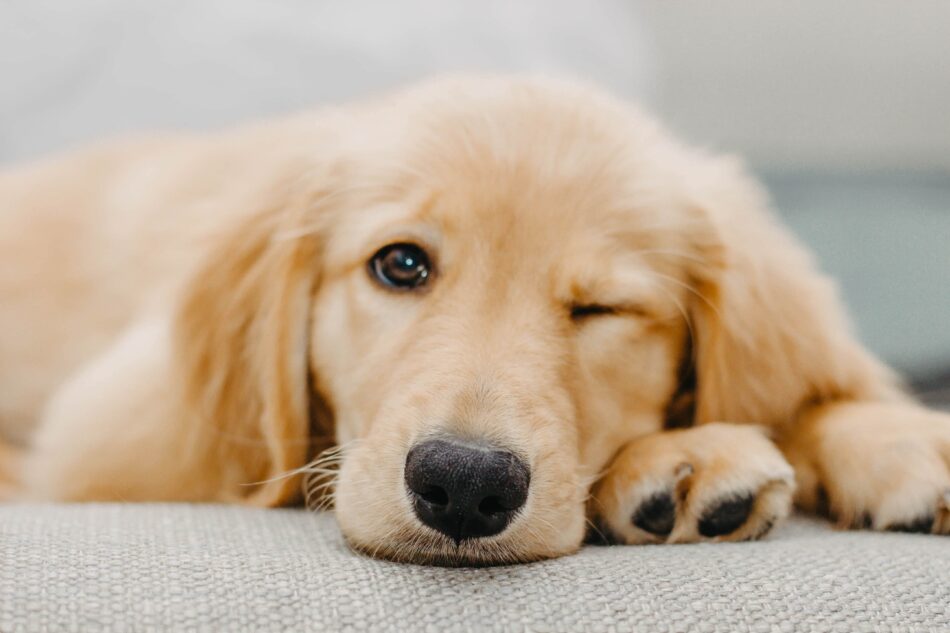
This entry was posted in Dogs
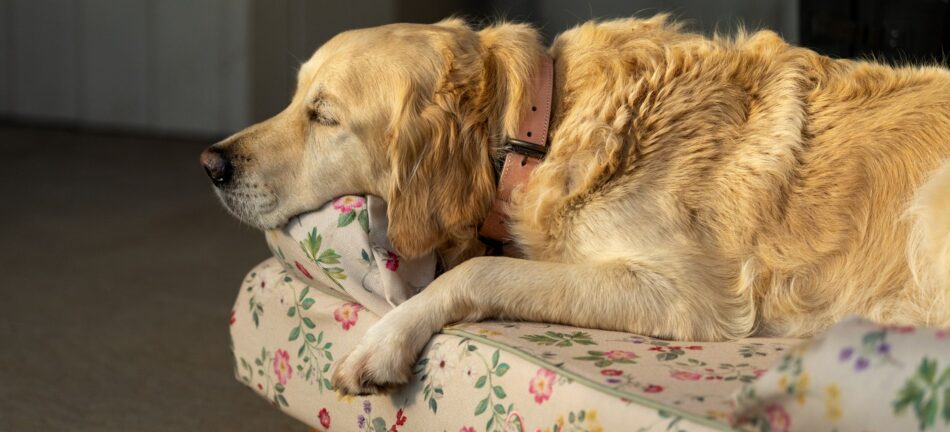
If you’ve ever visited a shelter or rescue, you’ve likely seen a wide variety of dogs of different ages looking for their forever home. But if you’re looking for a canine companion that’ll provide you with lots of love, fewer growing pains and a chance to slow down and enjoy life more, look no further than adopting an older dog.
Caring for a dog of any age requires work and patience. And while older dogs may come with a few more responsibilities than other rescues, don’t let those grey muzzles deter you. Adopting an older dog will save their life, but the rewards you get in return will be far greater. Let’s take a look at everything you should consider before adopting an older dog.
At what age is a dog considered old?
When it comes to a dog’s age, does it really matter? There are many misconceptions about how old a dog is when they reach their ‘senior’ years because a lot of the ageing process is heavily dependent on the specific dog breed. Many believe that a dog is technically an older dog by the time they reach the age of 7 because of the infamous 7 to 1 human to dog years rule. In other words, a 7-year-old dog would equate to the age of 49 in human years by comparison. But we’re betting there are a lot of people in their late 40s who would argue they’re not yet old!
To really try and understand if a dog is an older dog, you can look at their breed-specific average age span and then calculate the last 25% of their life as being their senior years. So, for example, if a dog’s predicted life span is 11-12 years, then their senior years would likely start around age 8 or 9. Keeping in mind that these numbers are all averages and that every dog is different even among like breeds.
Why adopt an older dog?
The better question to ask yourself is why NOT adopt an older dog? Puppies and younger dogs are great, too, but with an older dog, you receive some extra benefits that are truly worth considering when looking to add another furry member to your family. Here are some reasons you should consider adopting an older dog:
- Already potty-trained: It would be rare to find an older dog that’s not already potty-trained. These dogs have been around awhile and ‘know the ropes’ better than their younger counterparts. So right out of the gate, you have one less basic skill to teach your new friend as they have likely already mastered it.
- Deeper connections: With age comes the knowledge of what it means to be loved by their person. Older dogs have a much better understanding of this concept, and as a result, are usually quicker to form a strong bond with you.
- Calm temperament: If you’re seeking a chilled canine companion who would rather snuggle on the sofa than chase you in the yard, then an older dog is where you should look. While older dogs still have energy to run and play, their puppy years are far behind them and they tend to be more relaxed and calm.
- Second chance matters: You can rest assured knowing that by adopting an older dog you will not only be rewarded with love and appreciation, you will also have the gratification of knowing you gave them a second chance. Every dog deserves a home filled with love and great care, and older dogs should be no exception to that.
Teaching an old dog new tricks
They say you can’t teach an old dog new tricks, but the truth is, you absolutely can! The amount of training an older dog has under their belt will vary, but they almost all have the basics covered. Training any dog requires patience and work, but chances are with an older dog, they will pick up on new tricks quicker as they tend to retain lessons faster than younger dogs and puppies.
Keep in mind that older dogs do come with older bodies, so they could get injured more easily if given new tricks that are too challenging or difficult. For that reason, make sure you really know what you are getting yourself into before adopting an older dog. Take time to research the specific dog breeds and ages that are best suited for your lifestyle before bringing home your new best friend.
Gentleness and patience are the keys to helping an older dog settle in. For many, these dogs may have spent the last few weeks, months or even years in a shelter so they will be entering your life with some expected nervousness or anxiety. Ensuring they have an easy transition into your home will require patience and time to let them get used to their new surroundings and routines.
Senior dog essentials
While every dog breed is different, most older dogs want to spend the rest of their best years doing what they love most – relaxing! So in order to make sure your older dog is as comfortable as they can be, here are some essentials you should have:
- Supportive dog bed: Just as mattresses are important to us as we age and change, so too are the beds that our dogs sleep on. And that is especially the case for older dogs. To give your older dog the most comfortable sleep, you need a supportive memory foam mattress that will provide the utmost comfort for their joints and muscles. The Topology dog bed, designed by Omlet, is not only a practical and stylish bed for your older furry friend, but it’s engineered with versatility for you to customize specifically for your dog!
- Temperature regulators: Like us humans, dogs tend to become more sensitive to temperatures the older they are. These senior pups are more susceptible to heat stroke and heat exhaustion as they age. So ensure they have a way to cool down fast when the temperatures rise by getting them a cooling dog mat that can be placed on their dog bed or directly under their bodies for immediate relief. And to keep them extra cosy and warm in the winter, make sure you have plenty of soft, snuggly dog blankets to snuggle with.
- Easy clean options: All dogs like to sleep but older dogs like to clock in a few more hours each day than their younger canine counterparts. Because your older dog will be spending more time snoozing, you want to make sure you have a dog bed that is easy to clean and care for so as not to disrupt their coveted nap times. The Topology dog bed toppers are a great option as they are machine washable and easy to clean. Keep an extra one on hand so you can make sure your dog always has a fresh set of sheets to zip on.
Omlet and older dogs
There really is no better gift you can give to a dog or yourself than by adopting. Whether you choose a puppy or an older dog, the rewards you receive in giving these amazing animals a good life are priceless. At Omlet, our mission is to make products that help bring you and your canine companions closer together. From dog beds, to dog bowls and every dog product in between, we want the designs that we create to be just as comfortable, supportive and enjoyable for your dog as your connection is with them.
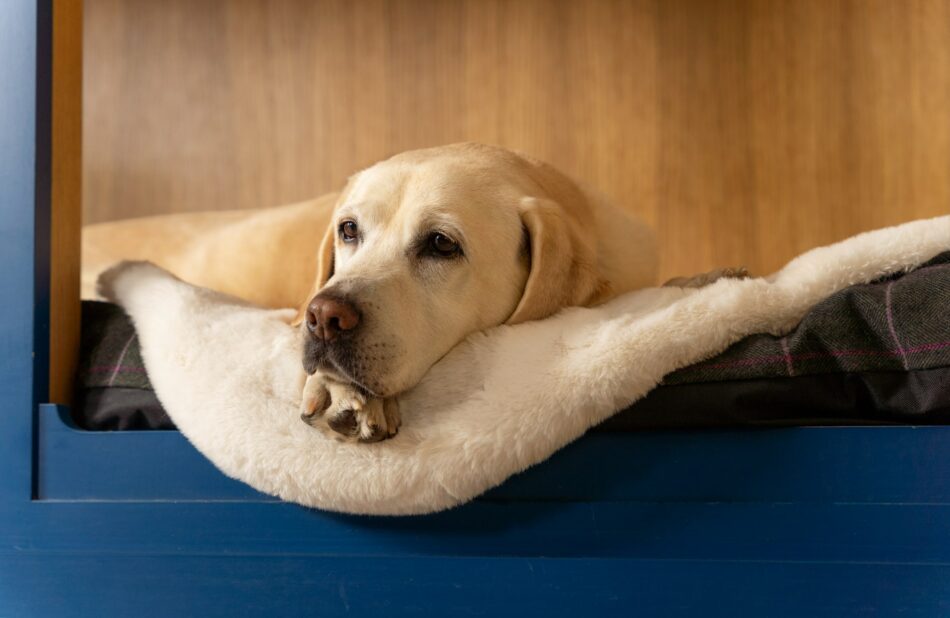

This entry was posted in Dogs
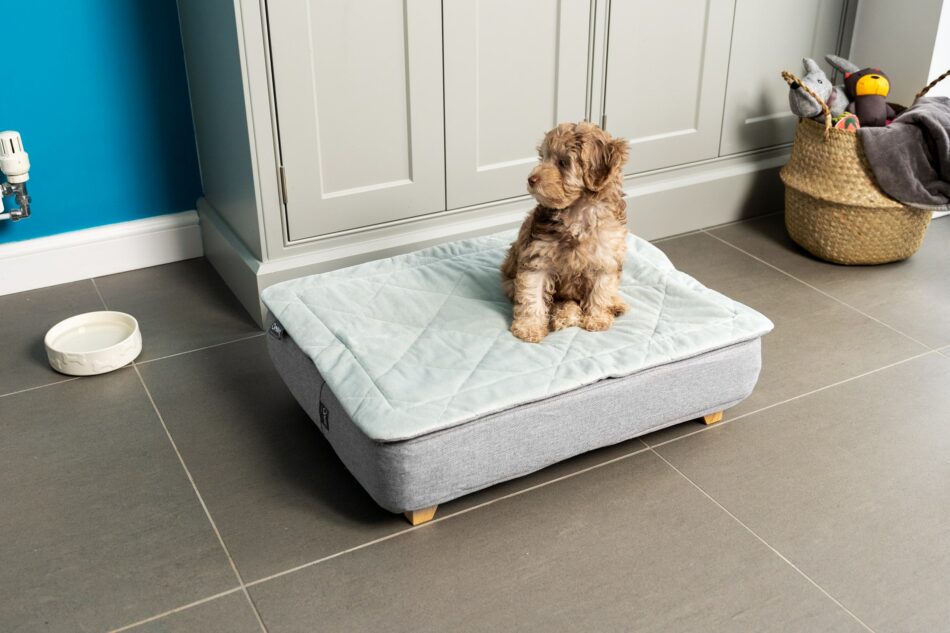
So you’ve added a new puppy to your family? Congratulations! Settling a new puppy into your life comes with all the highs of precious puppy snuggles as well as the lows of “Did they chew my shoes again?!” To help you make this transition easy, we’ve gathered everything you need to know on how best to settle in a new puppy. From simple steps to puppy products, Omlet has the advice you need to make the adjustment period smooth for everyone.
Puppy’s first 24 hours
Here’s the thing about adding a puppy to your family – it’s a lot of fun, but also a lot of work. Before you bring your new furry friend home for the first time, you need to make sure your home is prepped and puppy-proofed and that you have stocked up on all the new puppy essential products.
The first 24 hours at home can be an unsettling time for both of you. Everything is new to your puppy – your furniture, the space and even the smells are all foreign to your new bundle of joy. So it’s normal to expect lots of sniffing, pouncing and even some potty accidents. Likewise, you may feel a bit unsettled having a new living, breathing bouncing playmate running around. Especially if you have never owned a puppy or dog before.
While the first day together may feel uneasy or unfamiliar, fear not – it’s temporary and you both will start feeling settled in, in no time. Here are a few steps you can take in the first few weeks to make the homecoming less stressful and more enjoyable.
Introduce your puppy to their bed
Just like you have your personal bedroom where you sleep every night, you want to make sure you designate a spot in your home that is specific to your puppy as well. Having a familiar place to go to will allow your puppy to feel more comfortable and secure as they’re settling in.
The easiest way to create the perfect puppy place is with a dog bed. Not only will this be their spot for rest, but it will soon become their safe haven from any disturbances or distractions that might make them feel uncomfortable.
The Topology Customizable Dog Bed designed by Omlet is the perfect bed for a new puppy as it will not only grow with your puppy into adulthood, but you can customize it to their needs along the way. Engineered with a solid base and superior memory foam mattress, the Topology offers a wide selection of toppers that are easily zipped on and off the bed. This not only allows you to pick a personalized topper from a variety of fabrics and colours, but it makes cleaning the dog bed as easy as one, two, zip.
Each topper is made from durable, hard-wearing materials so even the toughest of new puppy teeth can’t chew through them. Our recommendation for puppies is the Quilted Topper as the soft, plush feel will give them unbeatable comfort while also maintaining the strength to resist a hard teething session – and it’s covered by our 180 Day Puppy Guarantee.
Keep visitors to a minimum
When you bring your new puppy home, it’s tough not to invite your mom, cousin, neighbour and even your local grocer all over to see your adorably cute new furry friend. But try to resist too many visitors over the first few weeks.
While socializing your new puppy is important, having too many visitors at once can actually become overwhelming and cause stress. So when it comes to meeting new friends, slow and steady is the best rule of thumb.
And when you do welcome visitors into your home, be sure your puppy has a safe place they can retreat to in order to feel secure, such as their dog bed or even a dog crate. Nothing makes a puppy feel more settled than the comfort of their own space.
Show your puppy where to go potty
Toilet training your puppy is easy with these two simple steps: start early and be consistent. Whether you use puppy pads or the great outdoors, establishing a potty routine early on will make the process much easier on you both.
Keep in mind that your puppy is learning so much at this young age, so patience is key in potty training. Accidents will happen along the way, but with a regular schedule that starts the day they come home, your puppy will be potty trained in no time.
Let your puppy take it at their own pace
Having a puppy is kind of like having a toddler. Simple moments of playtime are filled with endless hours of excitement and it’s hard not to want to engage and play all day. But just like a toddler, all that play can make a puppy tired and knowing when to give them space is super important.
So make sure every family member is on the same page and knows how to give proper boundaries to the new addition. While it’s exciting to play with a new puppy, not all puppies want to play all the time. Every breed is different and your puppy will settle in at their own pace so long as you give them the space and time they need to do so.
Signs of a restless puppy
Imagine being transported to a completely new place you’ve never been to before and being surrounded by people and things you’ve never laid eyes on before. That’s exactly what it feels like for a new puppy when you first bring them home. All the new smells and sights can make a puppy feel restless but it’s important to make sure there are no underlying causes if the restlessness continues. Here are some signs of a restless, unsettled puppy:
Pacing
It is completely normal for your puppy to quickly traverse every room of your home during the first few days as that is how they learn about their surroundings. However, if you start to notice your puppy pacing back and forth in one particular area, this could be a sign that they are unsettled or even have some puppy separation anxiety.
When you notice this behaviour, try to limit your time away from home to frequent short getaways as opposed to long periods, if possible. And when you do have to be away for hours at a time, make sure they have a comfortable dog bed and dog crate where they can feel secure and comfortable.
Regularly waking up at night
In the first few weeks, puppy sleep is very similar to baby sleep – it’s sporadic. And while you can expect to be up a few times each night for the routine potty breaks, you want to make sure that your puppy can settle back to sleep easily for more rest.
When you start to notice they are up for more of the night than they are asleep, this could be a sign they’re unsettled. In order to help your puppy get their much-needed sleep, get them a Topology Customizable Dog Bed so they can rest with comfort, support and ease.
Panting
Unlike humans, dogs don’t have sweat glands all over their bodies. So in order for them to cool down, they often pant as a way to try and cool themselves off but panting can also be another way you can tell if your puppy is unsettled.
If you notice your puppy panting, first check the temperature and make sure they are not just hot and need a doggy cool down. Sometimes a nap on a dog cooling mat is all that is needed to keep the panting to a minimum.
Puppy teething 101
If you’ve ever had your finger in the crossfire of puppy teeth you know all too well how sharp those tiny canines on your canine can be. Between three and eight months of age, puppies begin to have an uncontrollable urge to chew as a way to help relieve the discomfort of their gums.
And while teething is a completely normal part of puppyhood, it’s also one of the main reasons why your puppy may feel unsettled. For some puppies, the development of teeth is painful and confusing and the only comfort they can get is in biting and chewing on things. So in order to help your puppy through this unsettling process, make sure you have plenty of puppy-approved dog toys around so they can chew away on something other than your shoes and furniture.
Omlet and settling in your new puppy
There are few things in life as exciting and soul-filling as owning a puppy. Not only are you establishing a bond with your new best friend from the very beginning, but you get to experience all the wonders of puppy smells and snuggles along the way. At Omlet, we curate our products to care for and comfort your dog from puppyhood and beyond. With custom solutions like the Topology Puppy Bed, we strive to be your one-stop resource for all things pet related. We know what it takes to make your puppy grow into a healthy and happy adult dog. So we make the products you need so you can focus on your incredible relationship with your puppy.
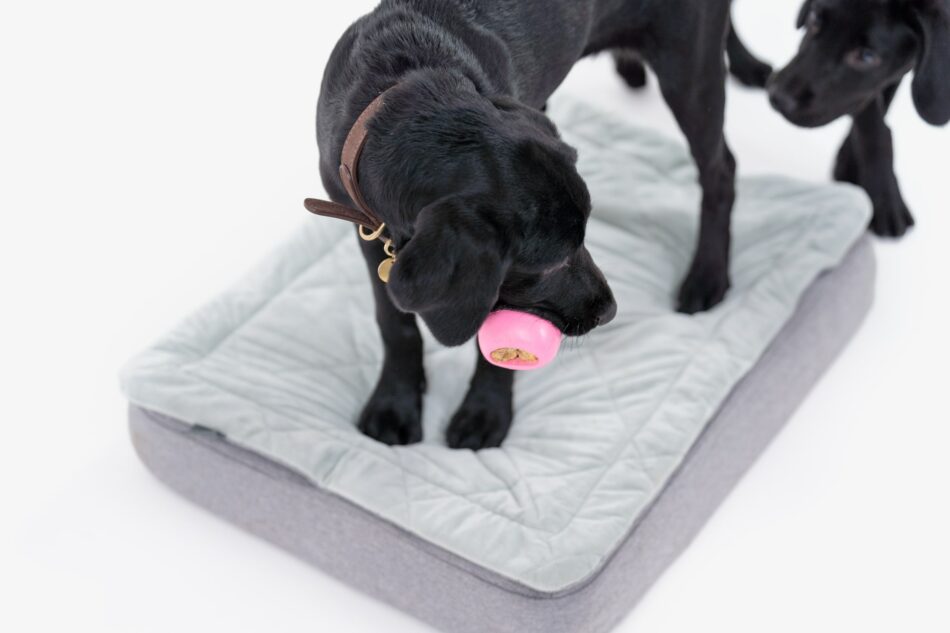
This entry was posted in Dogs
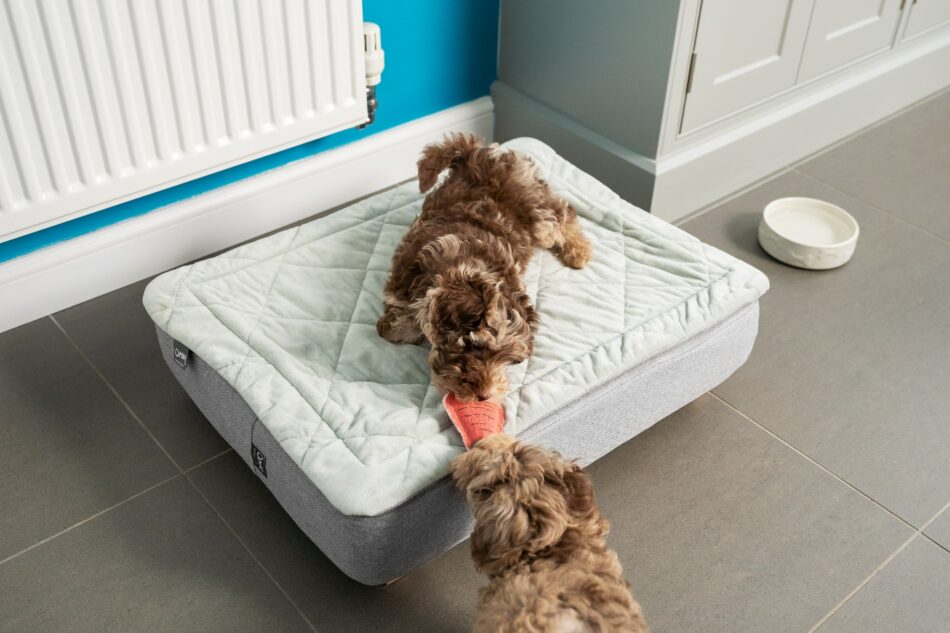
For puppies, the whole world is just one big chew toy. In order to explore their surroundings and everything in it, they use their mouths and teeth to chew through their curiosity. While this behaviour is extremely normal and expected, that doesn’t take away the fact that it can also be frustrating and destructive – especially to your furniture, shoes or even their dog beds. So if you’re a puppy parent wondering when the bite marks and chewed socks will end, keep reading. Omlet has the advice and products you need to help redirect your puppy’s chewing.
Normal puppy chewing behaviour
Just like babies, puppies experience pain and discomfort when teething. For the first 6 months of a puppy’s life, they spend much of their time chewing and biting as a way to help give their mouth and teeth some relief. It’s perfectly normal for puppies to chew as a way to strengthen their jaws, stimulate their brains and relieve anxiety – they literally can’t help it!
While some dogs can be mouthier than others, if you’re noticing your puppy chewing and biting excessively, there could be some underlying reasons to keep an eye out for. In the UK, most puppies can be adopted by a human family as early as 8 weeks old. However, sometimes these precious pint-sized pups are separated from their mother much earlier than they should, causing them severe separation anxiety and a heightened tendency to suck on fabric. As a result, puppies in this instance could display more chewing habits for longer periods.
In addition, puppies who are bored or not receiving enough attention once they are in your home could exhibit more chewing as well. But regardless if your puppy is a mild, moderate or mega chewer, this behaviour is only temporary and there are ways it can be redirected and eventually resolved.
Puppy-proof the house
The first golden rule of puppyhood that should be followed at all times is this – never leave your puppy unattended to roam free in your house. We promise it will lead to mass destruction! So the best thing you can do before you bring your puppy home is designate which room in the house will be the temporary puppy pad. We suggest a room with tile and not carpet.
The second golden rule of puppyhood is to remember to have patience. While the natural behaviour of chewing and biting can be redirected, it is a slow process that will take time and inevitably have many ‘slip-ups’ along the way. So be prepared to deal with several chewed-up socks, shoes and even dog beds.
Fortunately, Omlet has solutions as we know puppy chewing is nothing to be messed with.
That’s why we created our Puppy Bed to be durable enough to withstand the power of puppy teeth. In fact, we’re so confident in the engineered resistance of the quilted topper that we have a 180-day puppy guarantee on this style. In the unlikely event your puppy chews through the quilted topper in less than 180 days from purchase, we will replace it for free*.
Tips to redirect puppy chewing
While we do know that your puppy won’t be able to chew through their Omlet Topology bed, we are certain that they will find something else to chew on. After all, puppies will be puppies. So here are some ways you can help redirect your puppy from chewing anything else in your home.
Did you know that puppies can get bored? Kind of hard to believe given their bubbly and inquisitive nature. But it’s true, and puppy boredom can lead to a lot more chewing. So the best way to combat this is with exercise. Because after all, a tired puppy won’t chew as much.
Just keep in mind that at their still very young age and susceptible systems, puppies can’t go on long walks or romps at the dog park. So finding ways to play with your puppy indoors is key to keeping boredom at bay. Any type of physical or mental stimulation will help alleviate the need for excess chewing.
Just as toddlers need lots of toys for added stimulation, so do puppies. So be sure you have several dog chew toy options on hand for your puppy to use. Just don’t give your puppy old socks or shoes as chew toy options – that will only cause confusion when they try to chew the new shoes left at the door.
You can also rotate chew toys every few days so your puppy has something new to clench their chew with. When selecting toys for your pup, keep their size and age in mind so that you choose ones that are appropriate for their specific needs.
How about taking those puppy chew toys to the next level with Kongs. These super hard plastic chew toys are a great way to redirect your puppy’s chewing. Designed to stand up to the sharpest of puppy teeth, a Kong toy is a great replacement for a shoe, sock or even a piece of furniture your puppy has become fond of.
As soon as you see your puppy chewing something they shouldn’t give them a Kong toy to chew instead. In time, they’ll pick the toy over the furniture. You can even stuff the Kong with one of these easy-to-make Kong recipes. Just make sure the ingredients are suitable for your puppy before serving.
What do you do if your puppy is more attracted to electrical cords instead of shoes for their chewing regularity? That can be dangerous! In the event you see your puppy going after cords or really anything that is an absolute ‘no chew zone’, you can use a repellent as a way to redirect.
Dogs hate the taste of anything bitter, so spray a bitter apple spray on the items that you want them to stay away from completely. Just make sure your spray is natural and non-toxic and it will be a safe measure to take in redirecting their chewing.
How NOT to redirect puppy chewing
It’s really important that you avoid any negative reactions or consequences as a way to redirect their chewing. You have a lifetime to look forward to with your new furry friend and if you try to stop their innate chewing behaviour the wrong way, it could lead to less trust later on. So here are a few tips on what not to do in redirecting your puppy’s chewing.
- Never place a muzzle on your puppy’s mouth
- Never try and clamp their mouth shut with your hand
- Never use a dog crate as punishment tool for chewing
Omlet and your puppy
As the experts on puppy behaviour, we know all too well how normal and frustrating the first few months of puppyhood chewing can be. That’s why our Omlet designers create products that are both beneficial and durable to withstand the power of puppy teeth. From a wide range of dog chew toys that are a perfect replacement for shoes and socks to our perfect puppy bed, which is engineered to go up against any good puppy chew session, Omlet has what you need to settle in your puppy.
*Find out more about Omlet’s 180 Day Puppy Guarantee here.

This entry was posted in Dogs

Every day we make choices that impact our environment and our carbon footprint. But what exactly does this mean? Without getting too scientific, the amount of carbon dioxide released into the atmosphere from the everyday things we do all equal up to an individual carbon footprint. Even our dogs have carbon footprints, or rather, carbon pawprints.
And just as you can make changes to your everyday routines to be more sustainable and reduce your carbon footprint, there are also ways you can help reduce your dog’s carbon pawprint as well. Even just small swaps here and there can have big positive impacts on the environment and those around us. So let’s take a look at some ways you and your dog can start living a more environmentally-friendly lifestyle.
What if a dog bed could live forever?
One of the biggest culprits to our planet’s carbon footprint is landfills. When waste piles up, over time, the disintegration of the trash combines to create gasses that are harmful to our atmosphere. One way we can do our part to reduce that negative impact is to throw less stuff away. And do you know what is one of the most common pet items thrown away each year? You guessed it – dog beds.
So we asked ourselves, what if a dog bed could live forever? What if we could make a product that would not only NOT end up in a landfill, but could stay comfortable and durable for the life of your dog? And then we crafted the solution. Designed as the forever sleeping solution for your dog, Omlet dog beds are not only curated with luxurious comfort, but they’re sustainably made to last a very long time.
With Omlet dog beds, you and your dog have a variety of options to customize your pet’s perfect sleep solution. When you purchase one of these dog beds, you receive a superior quality memory foam base that has the ability to be changed out with a selection of different fabric and color toppers. All toppers are machine washable so instead of throwing the bed away when it gets too dirty, simply wash the topper and your dog bed is back to new.
Reducing your dog’s plastic use
Raise your hand if you like to drink out of paper straws. Well, like them or not, the fact is that making a simple swap of paper for plastic in our drinking straws has a massive positive impact on our environment. And guess what? There are simple plastic swaps you can make for your dog as well to help reduce their carbon pawprint, too.
So the next time you need a new dog product, here are some more sustainable choices you can make:
- Dog bowls: What your dog eats and drinks out of is important not only to the environment, but to their health as well. Choosing a ceramic or melamine dog bowl, like Omlet dog bowls, allows your dog a cleaner way to consume their food and water. Keep them clean with frequent washing to keep the bowls around forever.
- Dog bed: We’ve already discovered a few dog bed options that allow you to clean the sheets and keep the bed. But what if there was a dog bed that stopped plastic going to waste? There is! Meet the Gardenia Collection dog beds designed by Omlet. With covers made from 100% recycled bottle fabric, these dog beds offer the ultimate environmentally friendly sleeping solution.
- Dog toys: Every dog loves to play with toys! But unfortunately, many dog toys are made from plastic. So try swapping even just one of your dog’s toys for a rubber dog toy option that is better for your dog and the environment! While these rubber toys aren’t 100% recyclable, they can be broken down into smaller pieces to be reused again!
Dispose of dog waste correctly
Owning a dog is one of life’s greatest treasures. Except when it comes to picking up their poop… While it may not be the most pleasant task, picking up after your dog is a task that must be done nonetheless. So how exactly can dog waste be eliminated differently to reduce your pup’s pawprint?
When out on a walk with your dog, what do you use to pick up their waste? Like most people, we’re guessing either a small plastic bag from your bag roll or just a plastic grocery bag. But guess where all of these plastic poop-filled bags end up? That’s right – back in the landfill. So to do your part in helping the environment and reducing your dog’s pawprint, simply choose different bags. You can pick from several options to include biodegradable, compostable and even leakproof paper bags. This simple swap may not make the task more enjoyable but it will make a huge difference to the environment.
Reconsider your dog’s grooming products
Sustainable and environmentally friendly products are not reserved exclusively for the items your dog uses every day. You can take the reduction of your dog’s carbon pawprint one step further by changing out the shampoo and conditioner you use next time you give your dog a spa day. By making small changes in your dog’s grooming routine, such as dog washes that are kinder to the environment, you will help your dog reduce their carbon pawprint even more!
Omlet and your dog’s carbon pawprint
At Omlet, we believe the connection between people and pets is something to celebrate. The products you buy your dog should matter to them, to you and to our planet. With a focus on quality and sustainability, we are able to make products that are both environmentally friendly and high quality, without compromising on comfort. From our Gardenia Collection designs, to our Topology beds to our selection of other sustainably made dog products, we continue to do our part to reduce carbon pawprints all over the world.
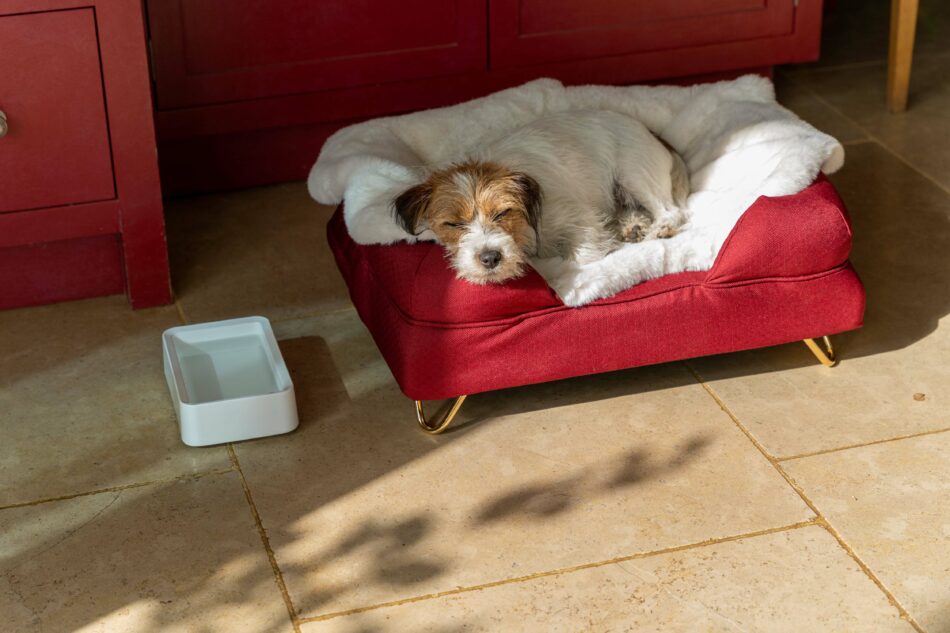
This entry was posted in Dogs
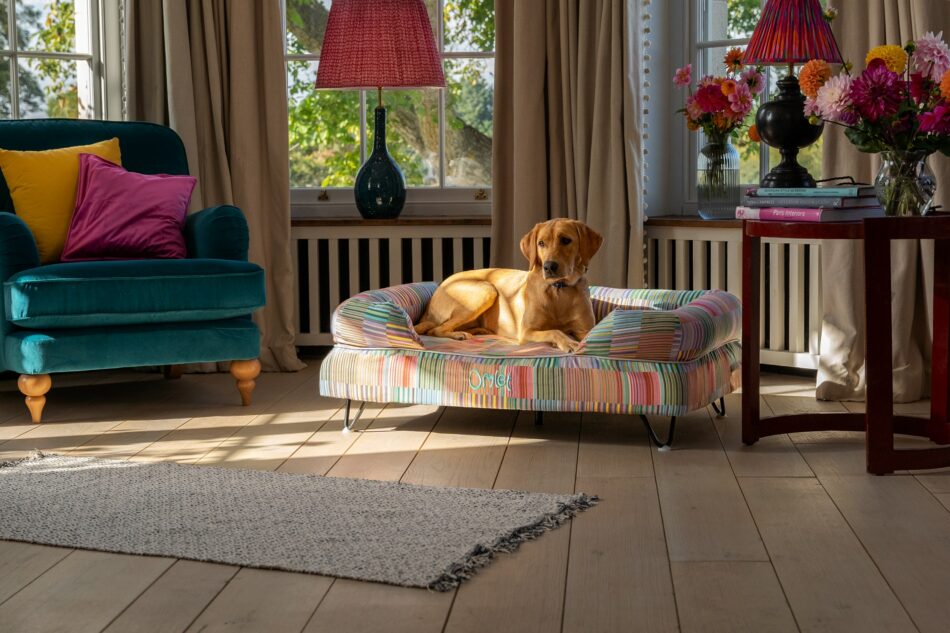
Every dog owner has their own version of their favourite dog walk. Through dense green forests or busy city streets, across pebble paths or rocky trails, every day we walk in step with our loyal, canine companions. This was the inspiration behind Omlet’s first limited edition collection of designer dog beds and signature prints. The Dog Walk Collection reflects the places we travel with our beloved dogs, to be remembered long after the walk is over.
Step into our world of walking wonder and unearth the journey of our first limited edition dog bed collection, designed by Omlet.
Meet the designer
Omlet’s in-house textiles designer, Victoria, is the ideator behind our first, limited edition collection of signature prints. As a dog owner herself, Victoria drew inspiration from the connection and companionship between dogs and their owners. Dog walks unite us in a shared experience, as we all travel in different paths but with collective joy. It was from this inspiration that the signature prints of the Dog Walk Collection were first sketched.
In this exclusive behind-the-scenes video, Victoria guides you through the origins of the designs and the step-by-step process of how she came up with each print. Follow along and uncover more about these unique and signature designs – which print suits your dog and their favourite walk best?
Inspiration for the patterns
Does your favourite dog walk reflect where you live, who you interact with and what makes your dog’s tail wag? We know everyone walks different paths and sees different sights, but ultimately, we all experience the same joy of spending quality time with our dog. Learn more about the walks illustrated in our 8 signature designs of the Dog Walk Collection and which connects with you most.
- Nature Trail: Born from the images of a serene walk in a deep green forest with soft teal tones.
- Pawsteps Electric: Influenced by the movement of paws and feet in the hustle and bustle of city life.
- Pawsteps Natural: Echoes the pace and peace of people and paws walking through cobblestone streets.
- Contour: Inspired by the hound who finds gratitude in every hill and hike alongside their companions.
- Morning Meadow: An experience of the glow of sun soaked fur and the smell of sweet scents of wild flowers.
- Midnight Meadow: Deep, rich floral tones are reflected in this slumber ready design.
- Forest Fall: Towering oaks and windswept walkers were the inspiration behind this print.
- Shaded Spruce: The only singular colour of the collection, this vibrant and rich hue serves as the heart of our signature prints.
Meet the Pawsteps
The unique patterns of the Pawsteps Electric and Pawsteps Natural prints are inspired by the movement of two and four legs in unison together. Some dog walks are fast, some are slow, some walks are with big dogs and others with small. But all dog walks are a time well spent with the ones you love most. And that was the vision behind these signature designs.
A juxtaposition of prints and places, the Electric print showcases fast walks in big cities and urban jungles where vibrant colours envelop the scenery. And the Natural print reveals the same movement of steps but in a more quiet place like small, quaint villages where time feels to go by slower.
Both of these prints are available in our new bed designs, the Cushion Dog Bed and the Nest Dog Bed, as well as Omlet’s best-selling, memory foam Bolster Dog Bed.
Walk in the Meadows
One look at the Meadows patterns will leave you feeling like you were lost in a field of wildflowers. These floral designs give you a sense of total immersion within a countryside where pastures, hedgerows and flowers all bloom with fragrant beauty.
While both designs reflect an almost scratch and sniff sense of wonder, they are uniquely created to illustrate the day and night paths that may be walked. In Morning Meadow, the vibrant colours of dog-roses and winter berries pop all over the print. And Midnight Meadow gives way to the feeling of sundown on the same bountiful countryside where a full day of adventure peacefully comes to a close.
Choose from three styles of bed, cushion, nest or bolster, for your dog’s rest in the meadows.
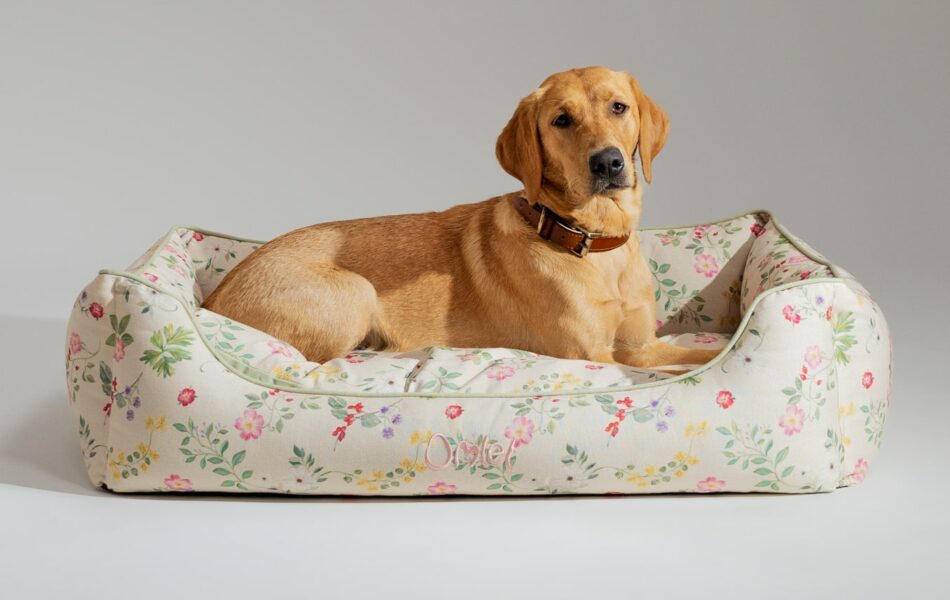
Fall for nature
If a walk amongst the trees and rich colours of the forest are what you and your canine companion love most, then the vibrant tones and patterns of Nature Trail, Contour, Forest Fall and Shaded Spruce will match you best. Designed from the feeling of being immersed in the natural essence of nature, each print is created to reflect the beauty of walks through tall trees and soft hues.
Both Nature Trail and Forest Fall create the feeling of a favourite path meandering through lush, green trees where the wind gently embraces your skin and fur. By contrast, the Contour print elevates the height of wonder with the same tree-lined path that now twists and turns on the hillside. And all of the rich teal tones that are seen stroked through your walk are captured in the only singular color print of the Collection, Shaded Spruce.
Discover your favourite path to walk in one of these prints available in our three styles of bed, cushion, nest or bolster.
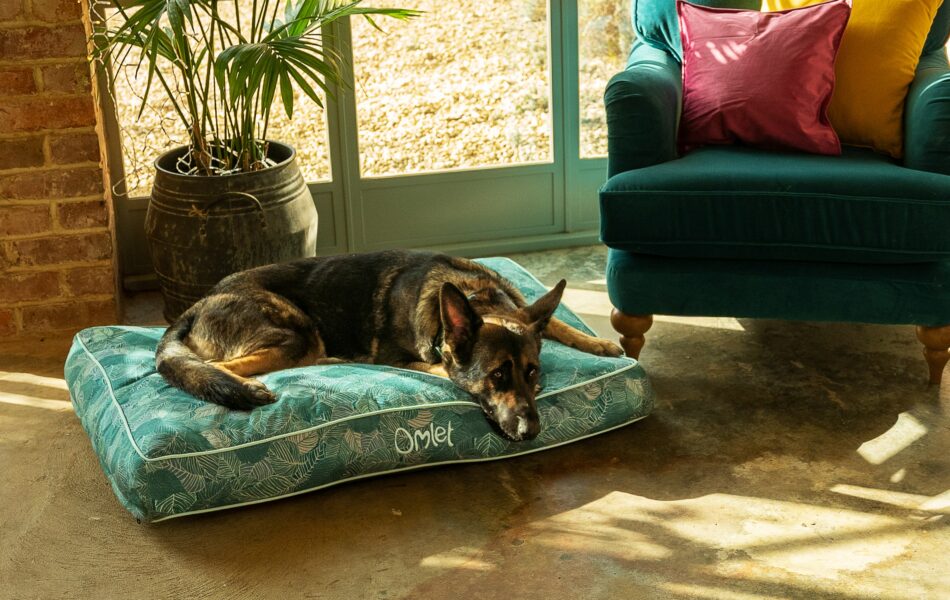
Let’s talk sustainability
At Omlet, we are committed to designing innovative products that are both durable and comfortable. Creating products that can be repaired, recycled and easily cared for are part of our mission to improve sustainability in the pet industry.
With our new signature print collection, we have made significant steps to a more sustainable dog bed, without compromising the quality of comfort. The dog bed covers in the Dog Walk Collection are made from 100% recycled bottle fabric. These bottles are turned into a yarn and woven into our luxurious and hard-wearing canvas fabric that is comfortable for your dog to rest on.
We meticulously researched and tested the use of recycled polyester for our dog bed stuffing but found the quality of the end product to be unsatisfactory for your dog. The stuffing flattens and loses its bounce quickly, compromising your dog’s comfort and reducing the longevity of the bed. This is why we decided to use virgin polyester to produce a high-quality, long-wearing and comfortable bed for your dog to use for many, many years to come.
We strive to make continued sustainable swaps to help you and your pet leave a smaller carbon pawprint on the world, and we’re proud to be making conscious and planet-friendly decisions every day.
Explore the Omlet Dog Walk Collection
A dog walk is more than just a stroll with your pet. A dog walk is a celebration of canine and companion as they share a joyful experience within the unique beauty that surrounds them. We invite you to explore the 8 limited edition, signature designs of the Omlet Dog Walk Collection and find a pattern that best celebrates your favourite walk with your dog. After all, the paths we walk may be different, but your dog’s path home to their bed is the one they look forward to the most.
This entry was posted in Dogs

































